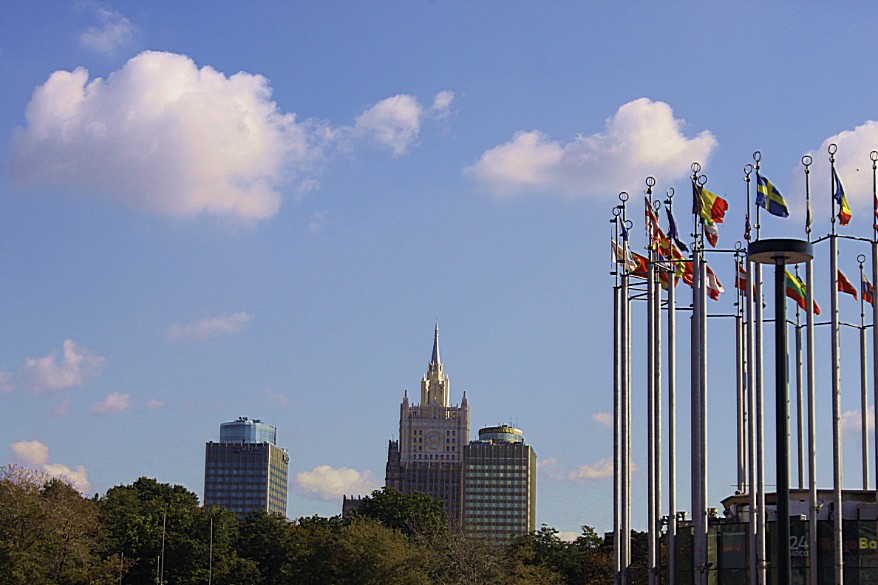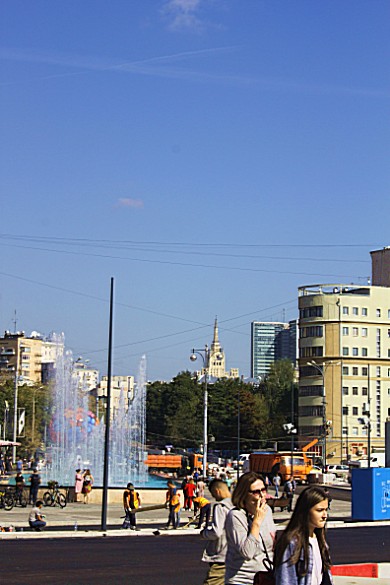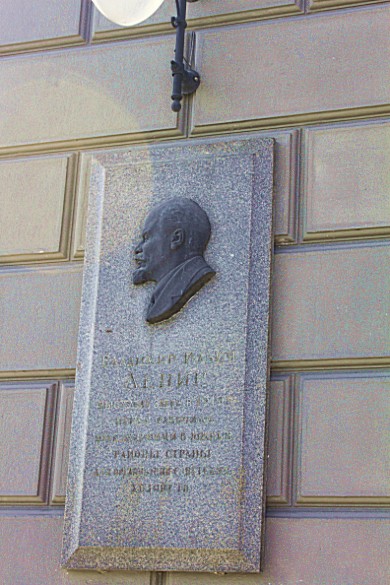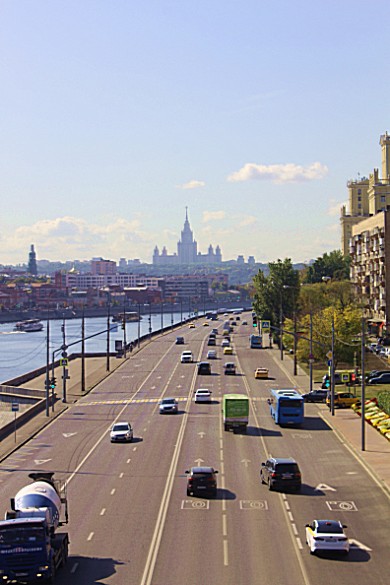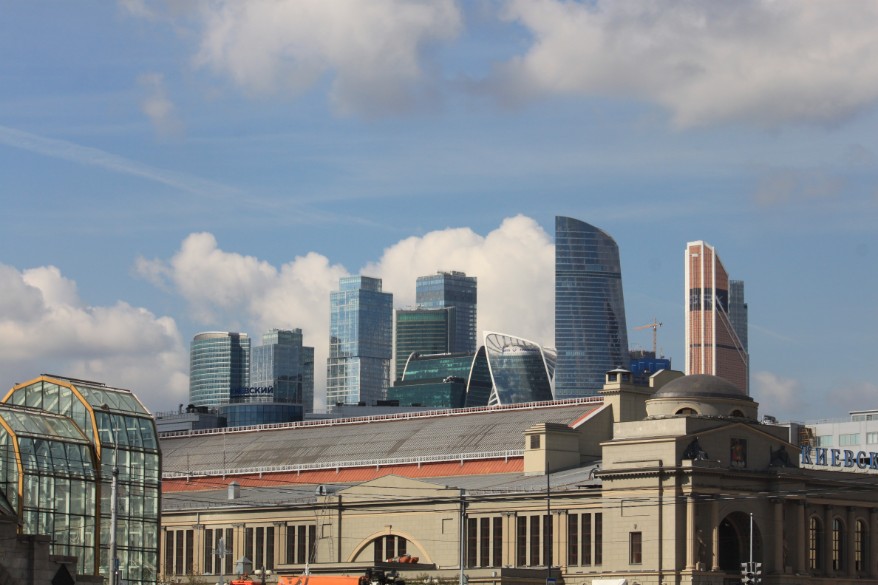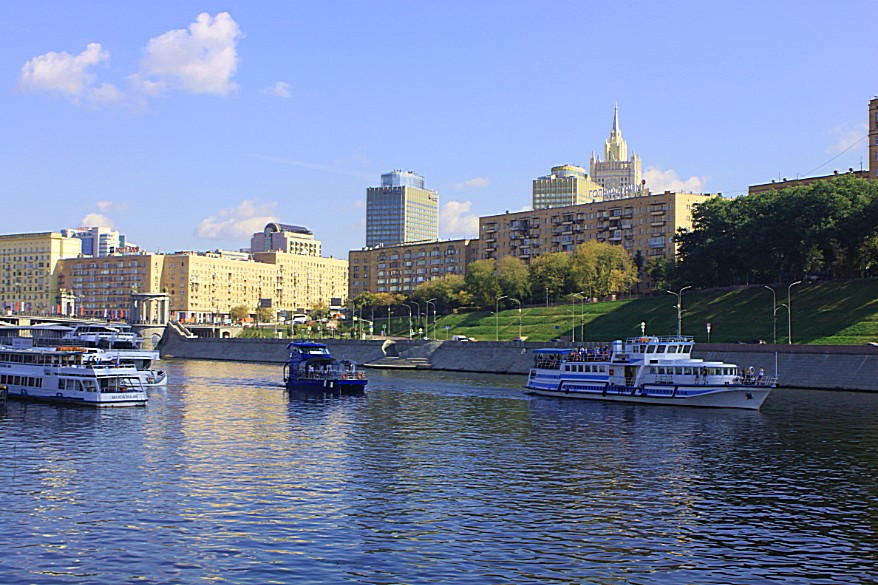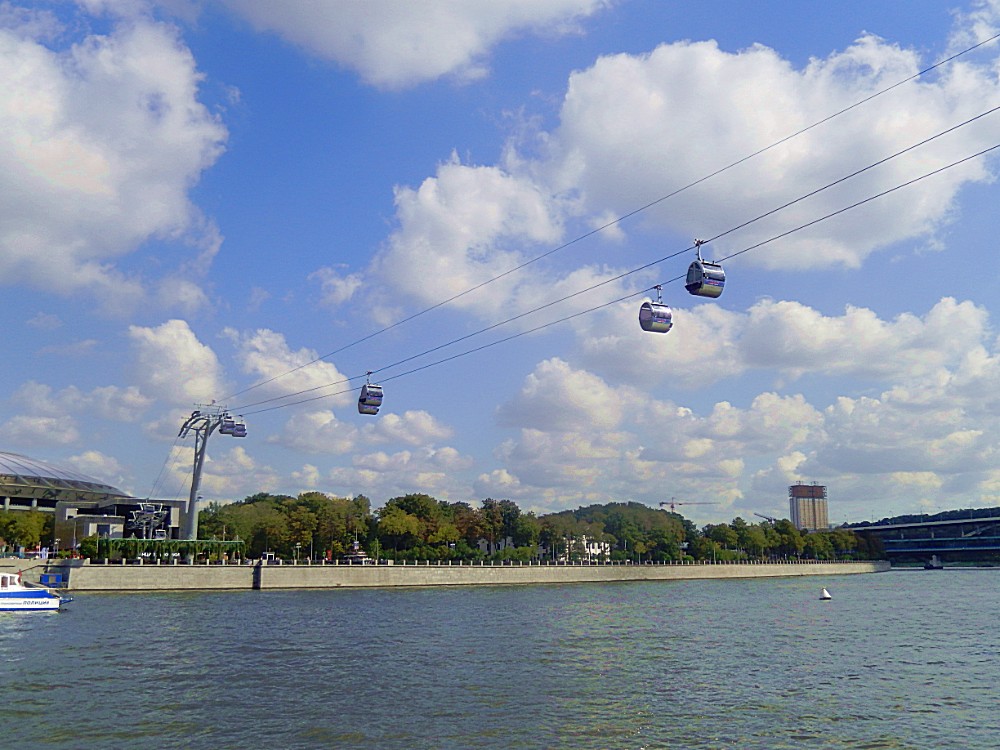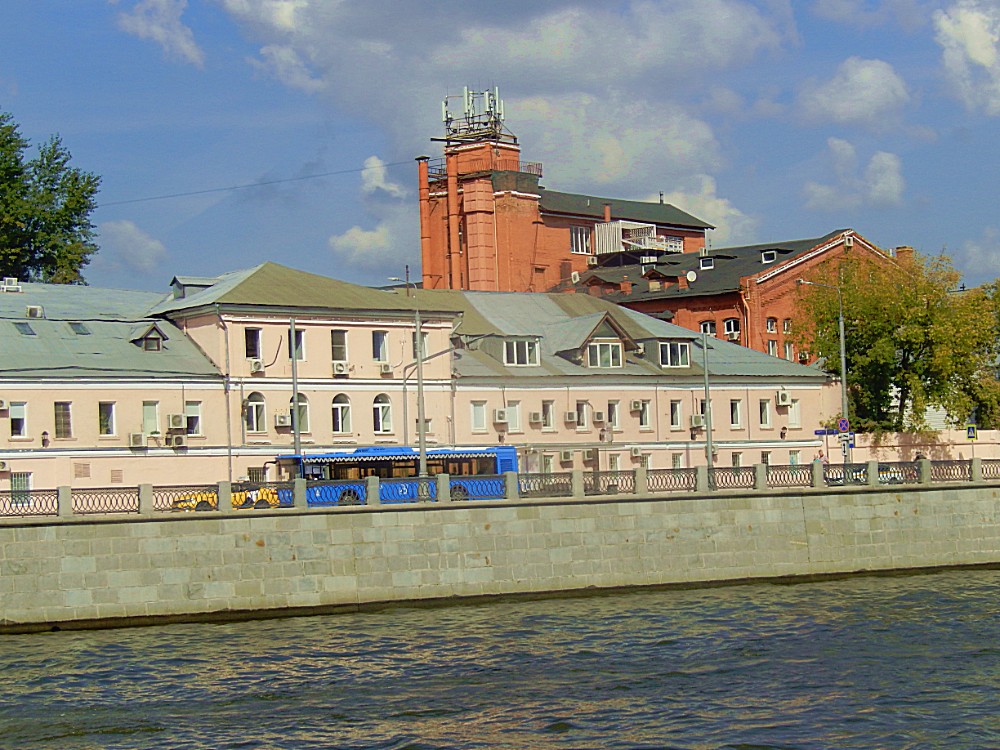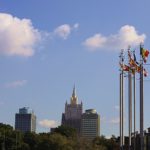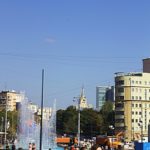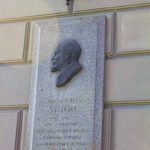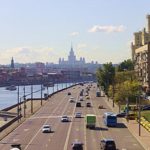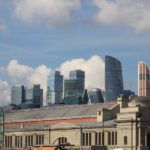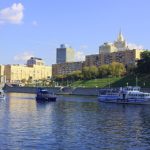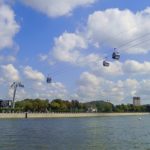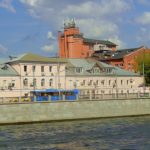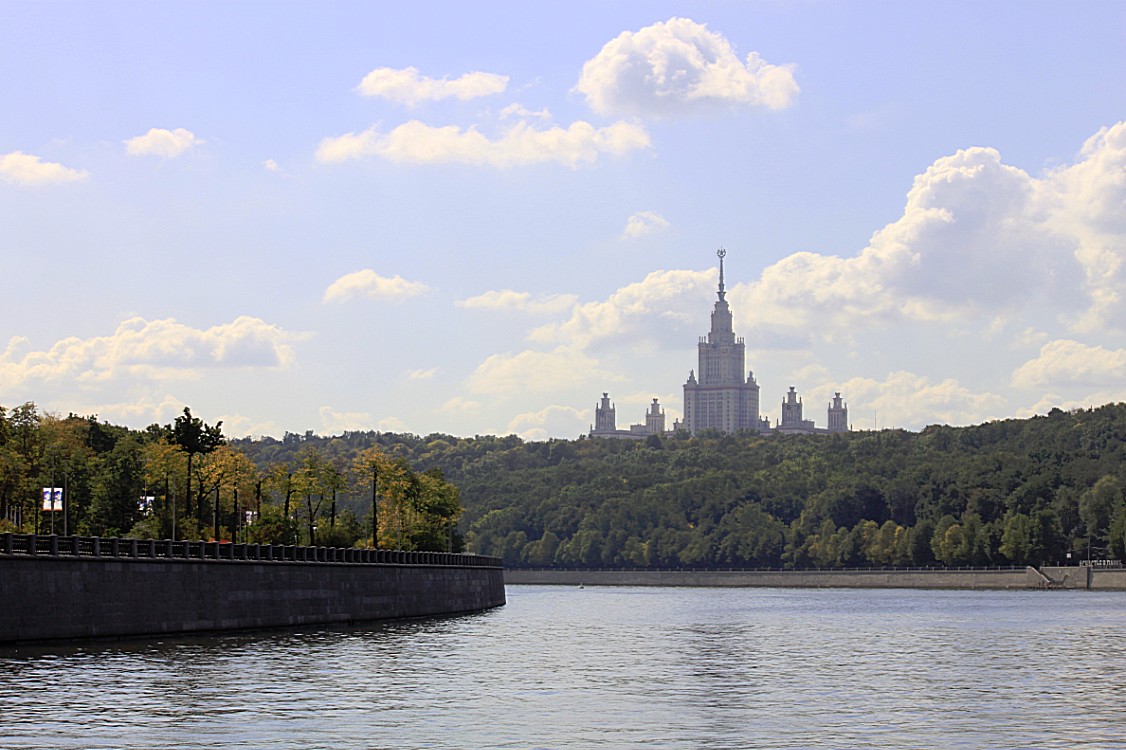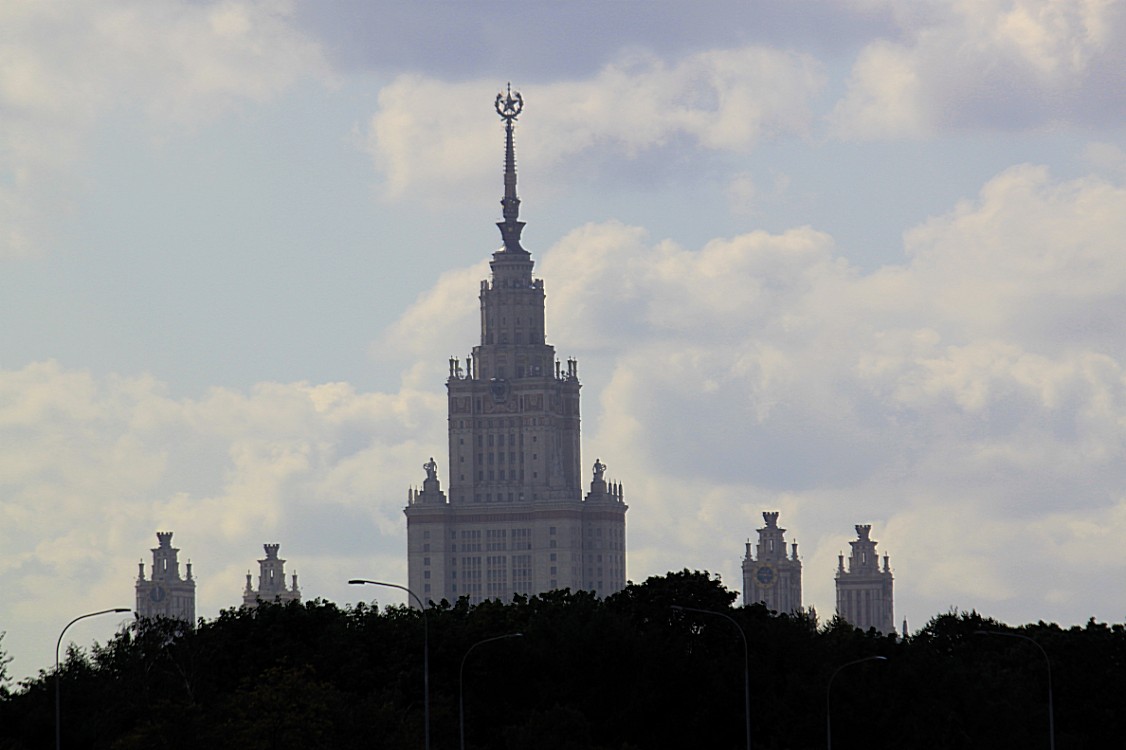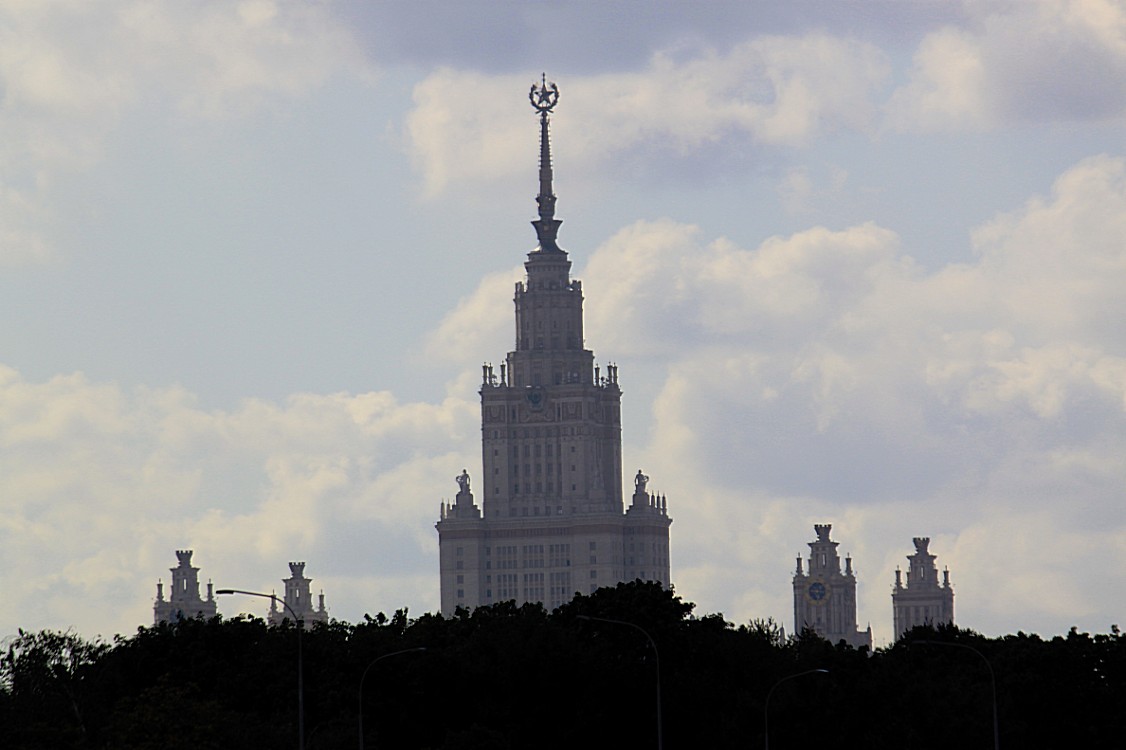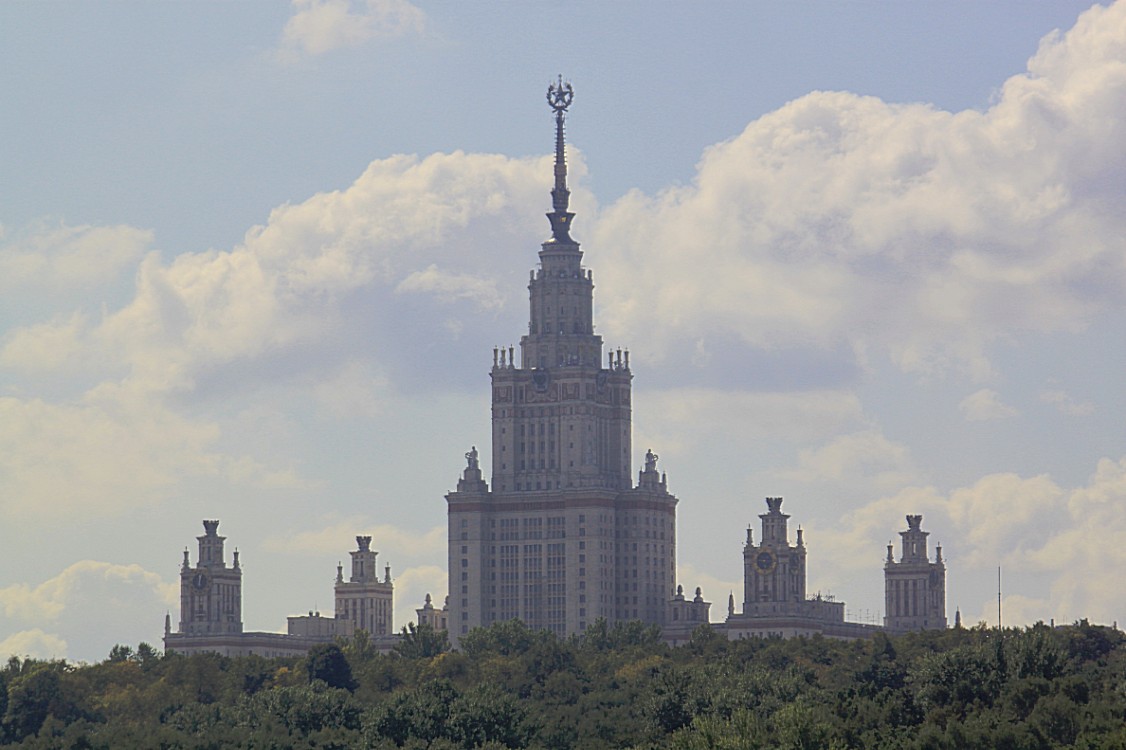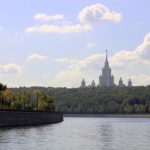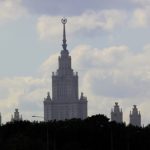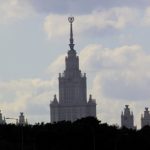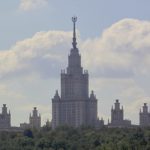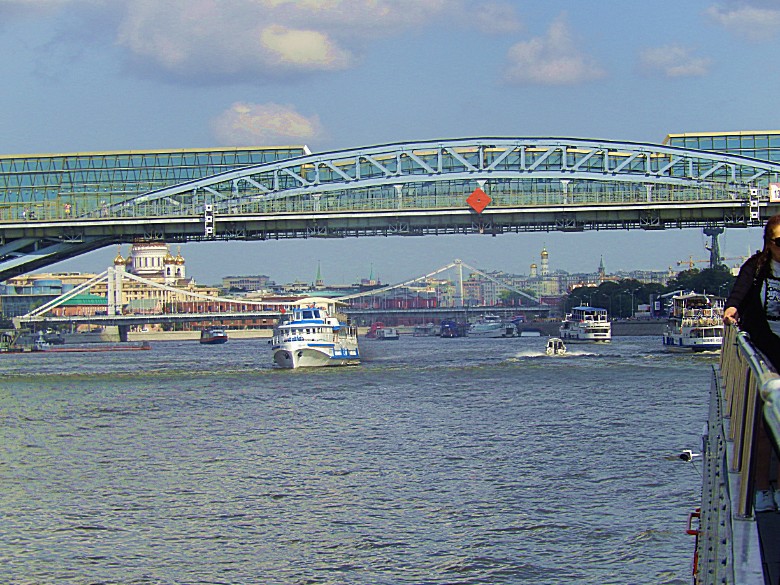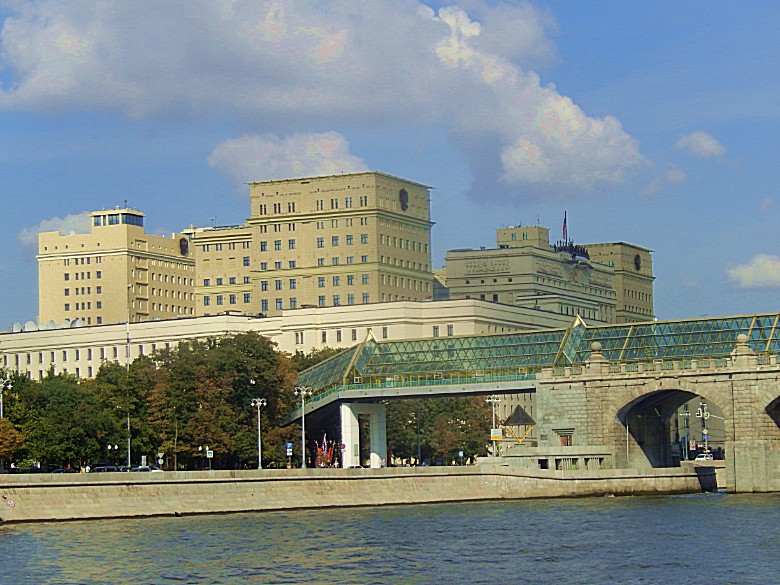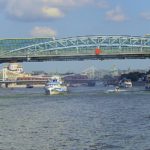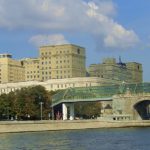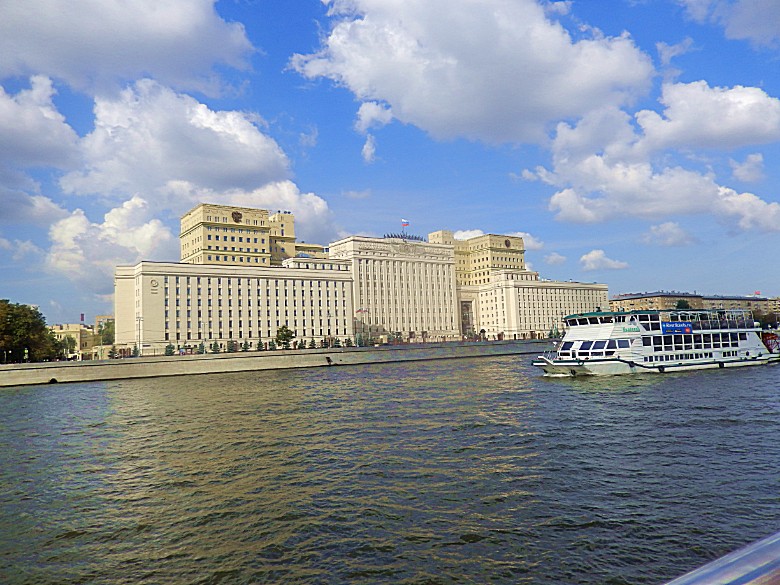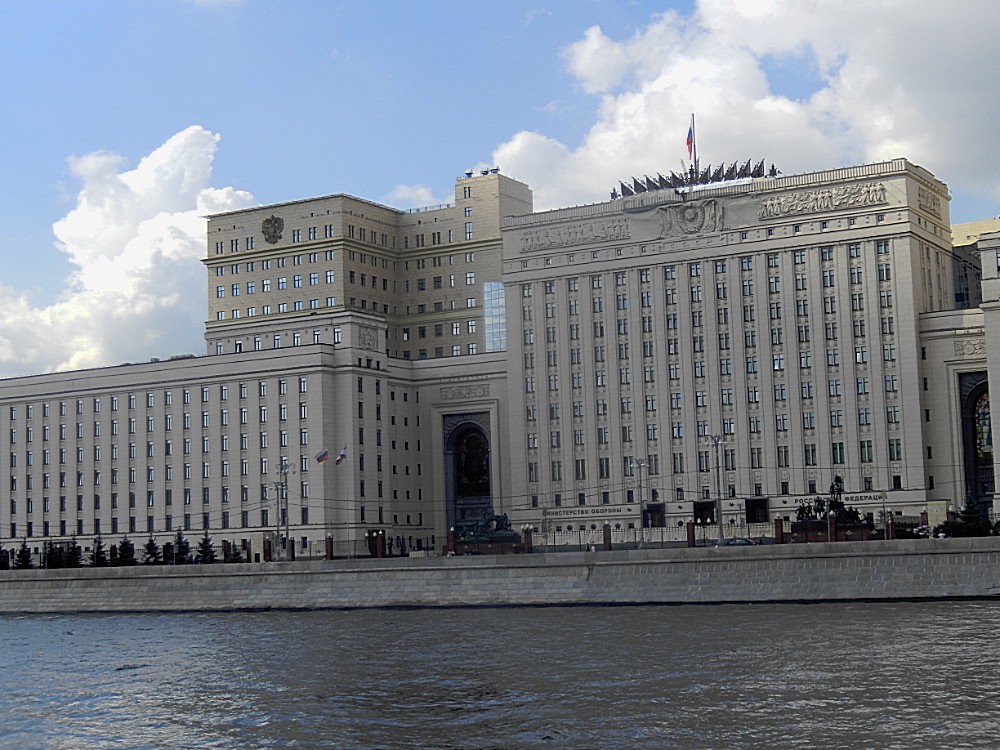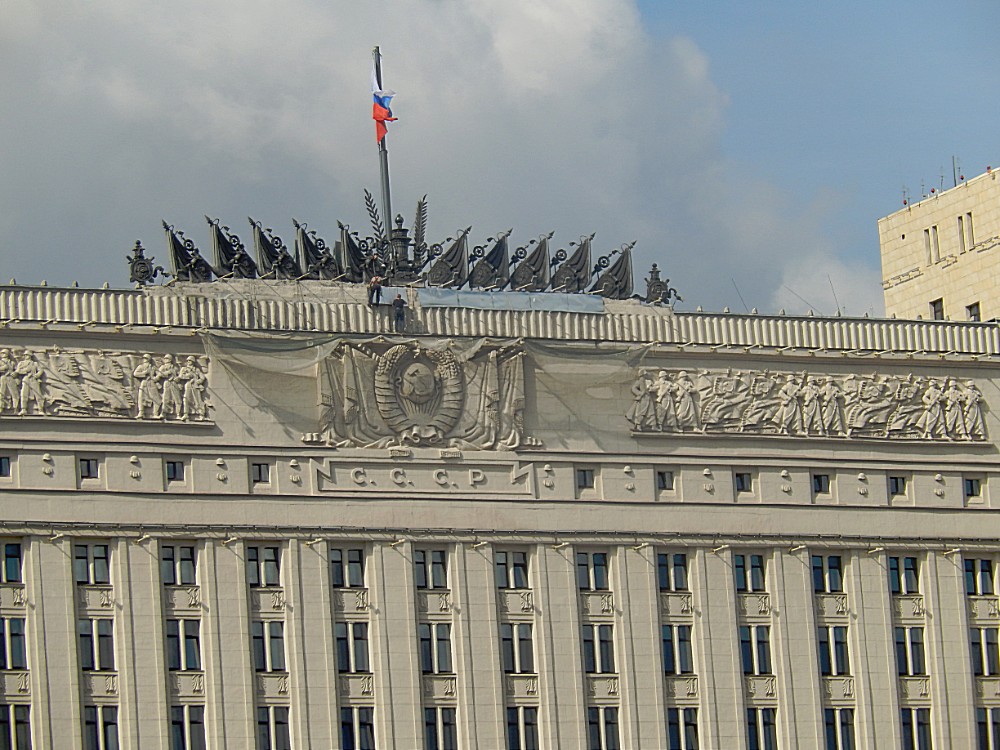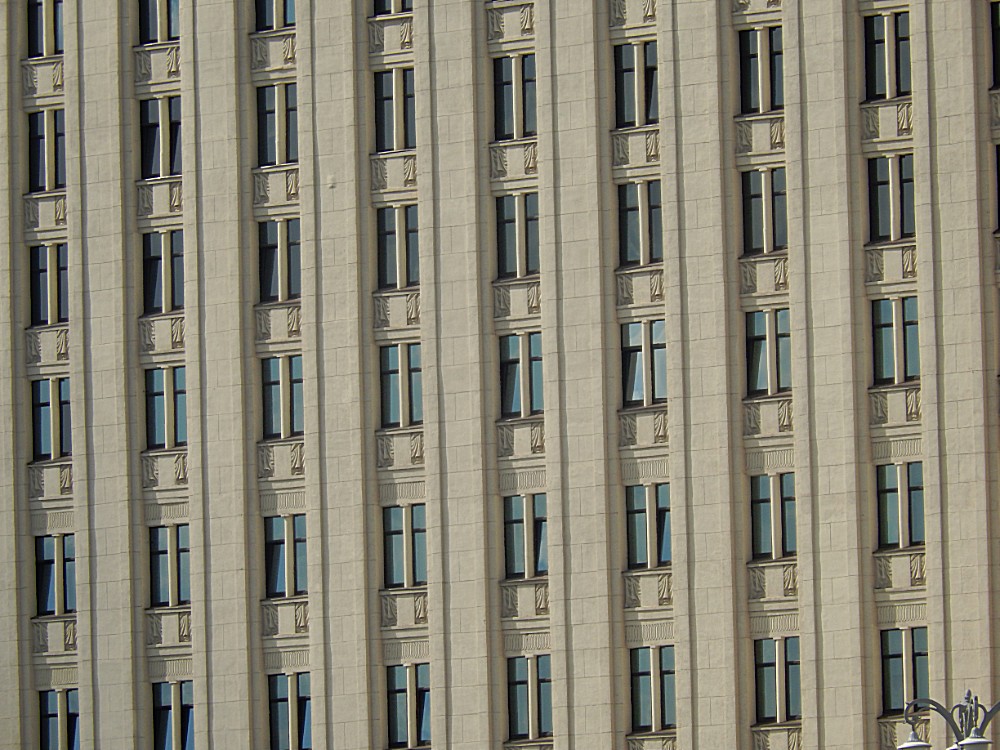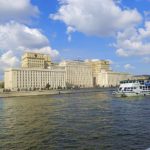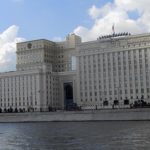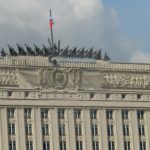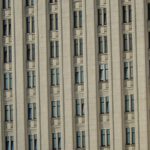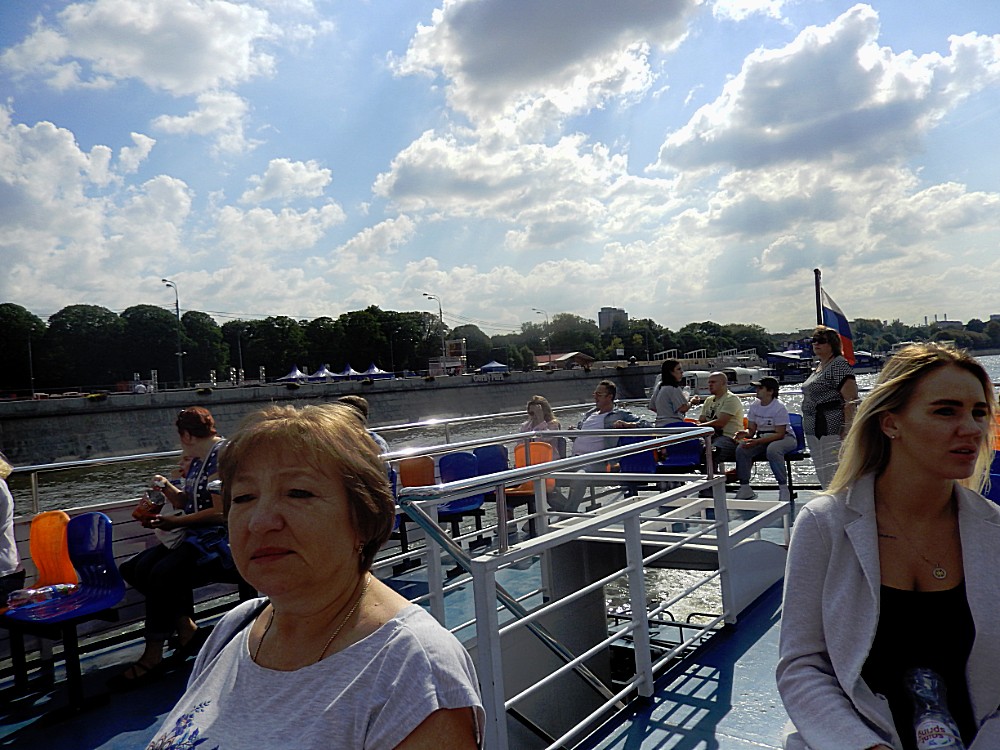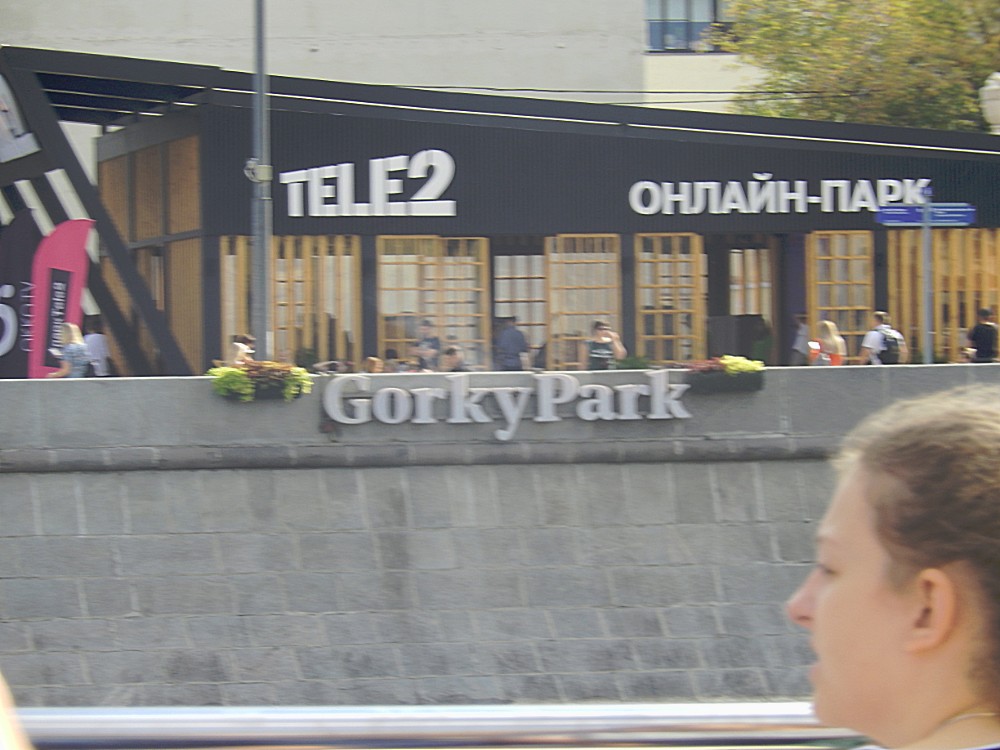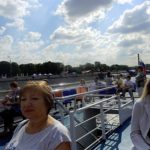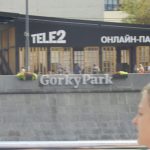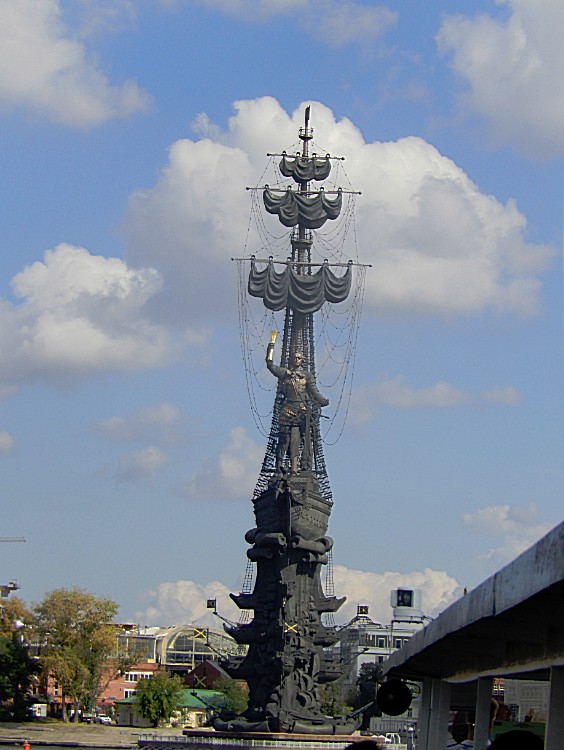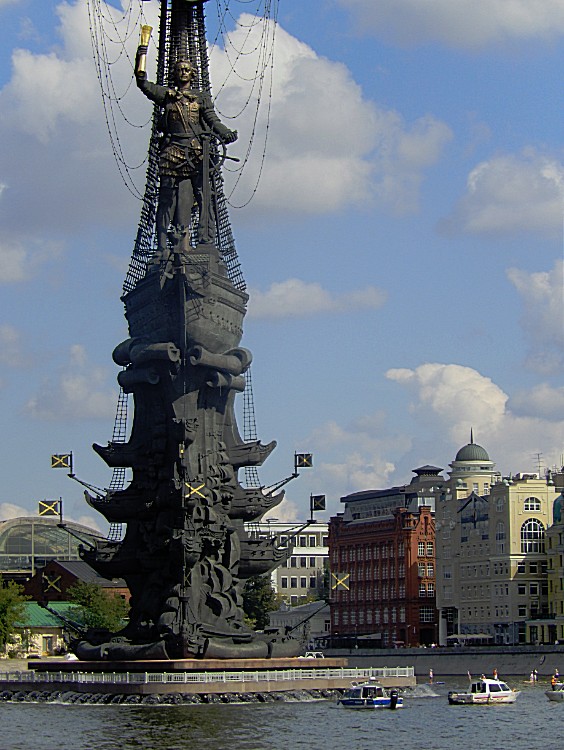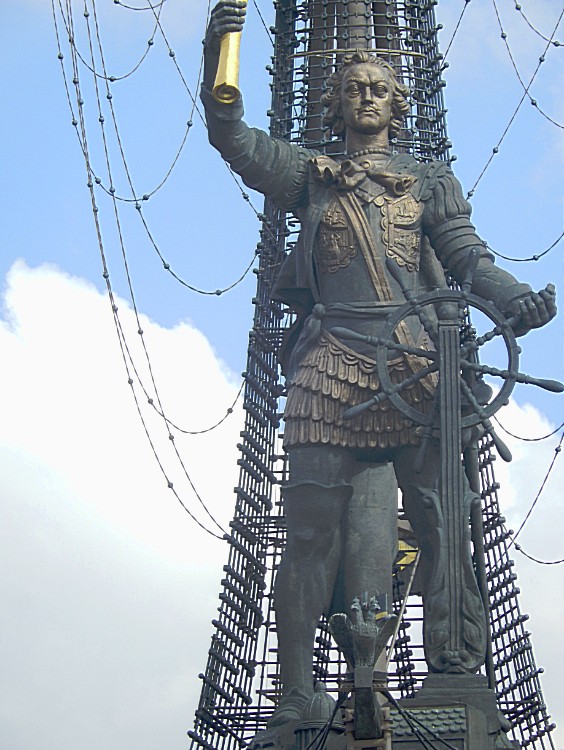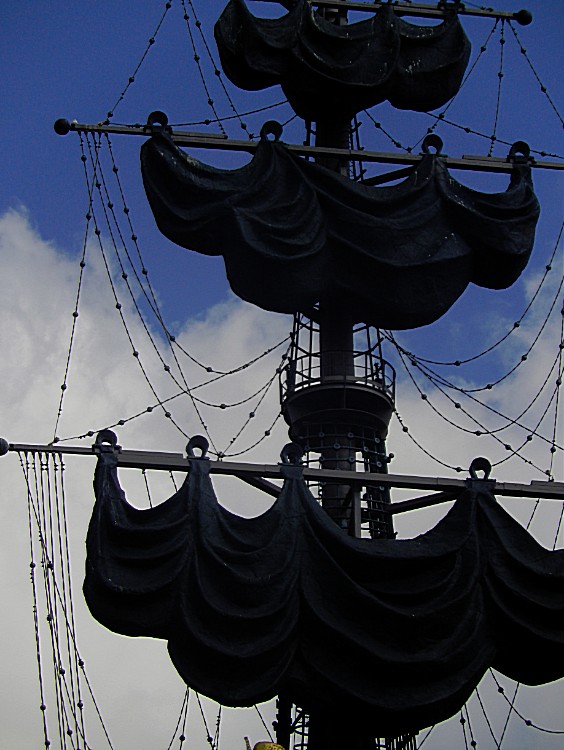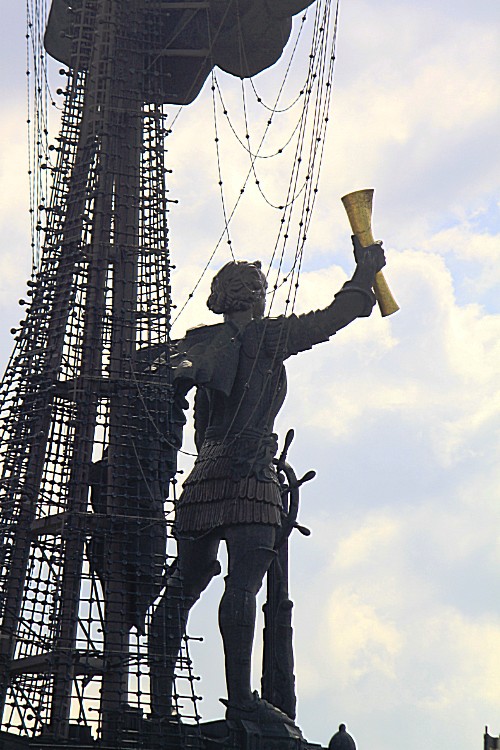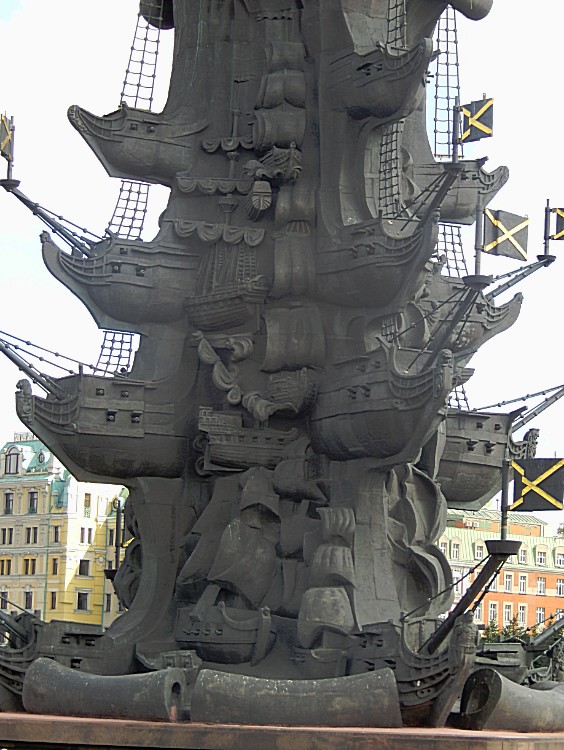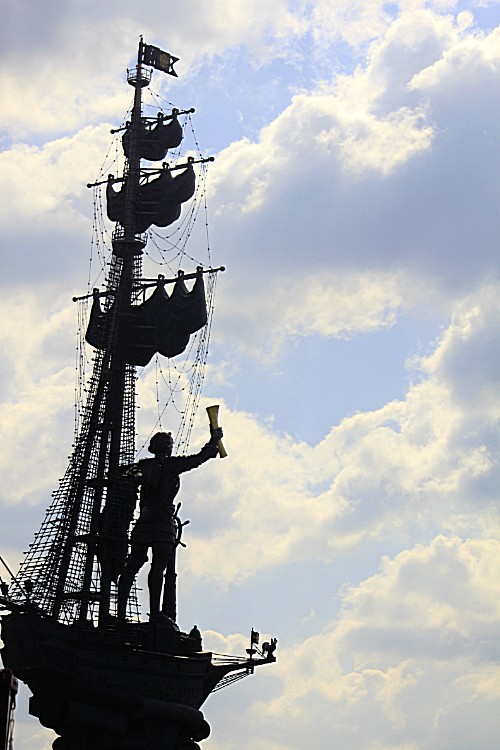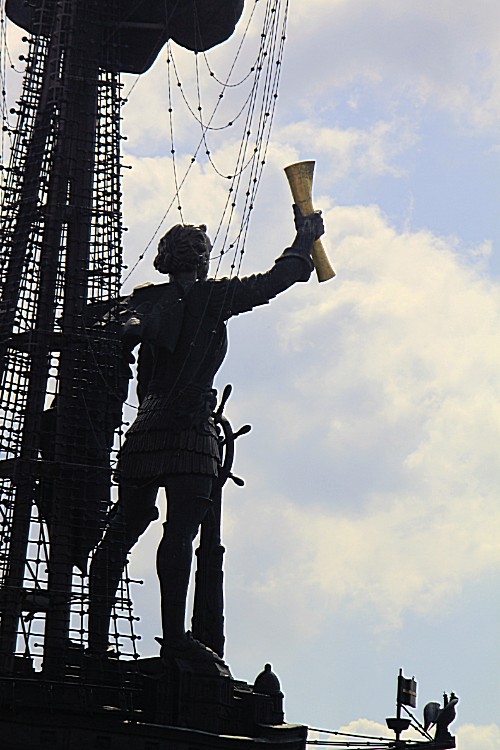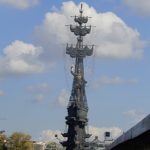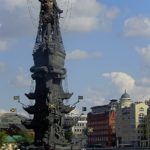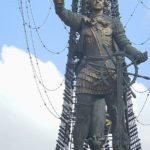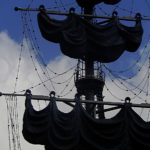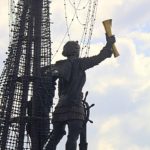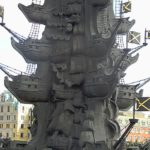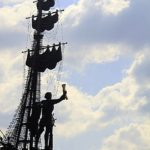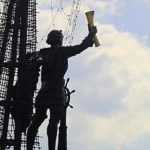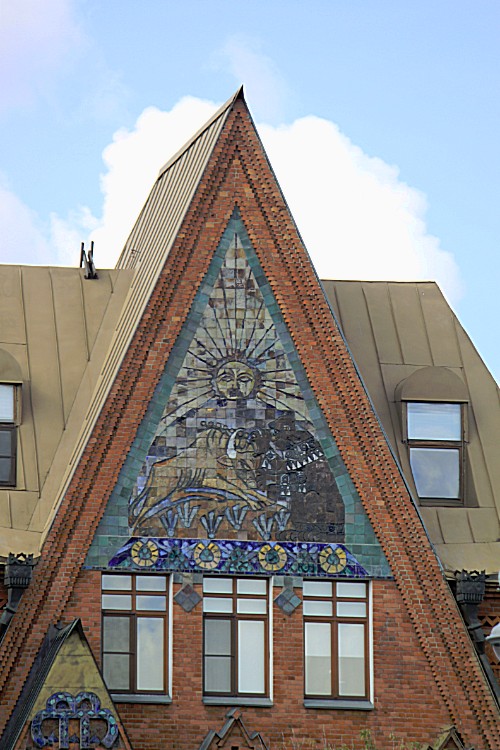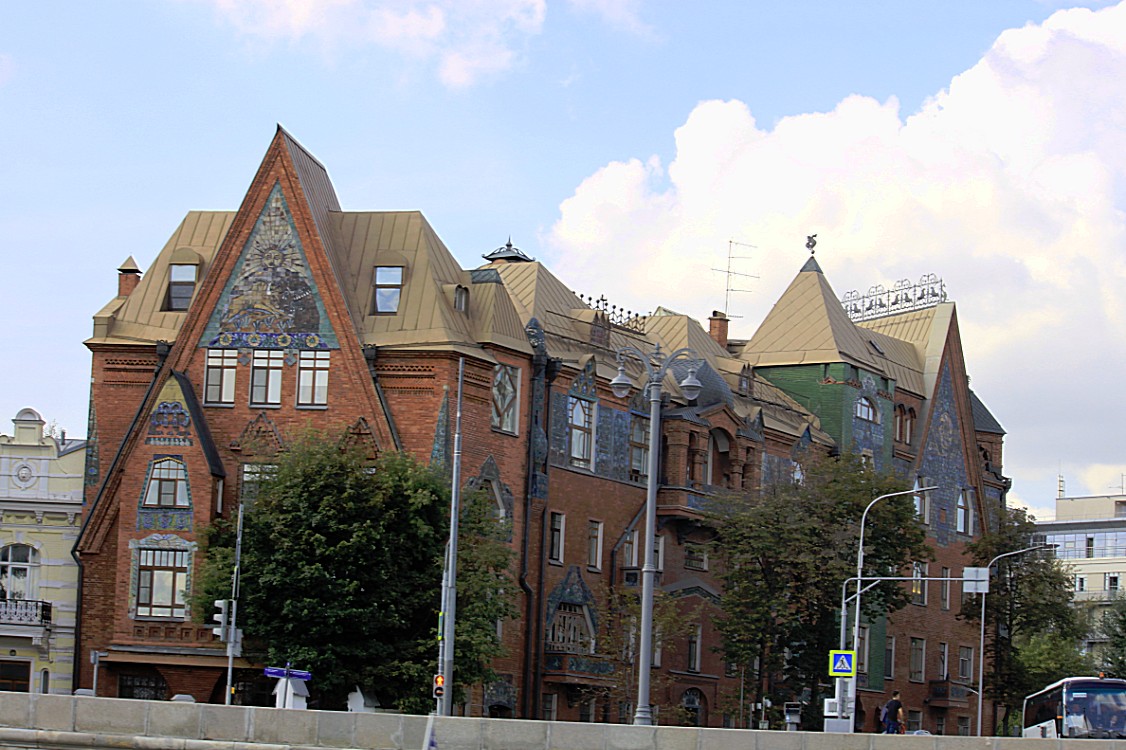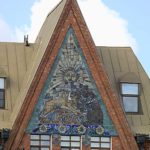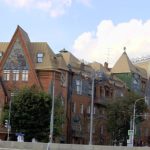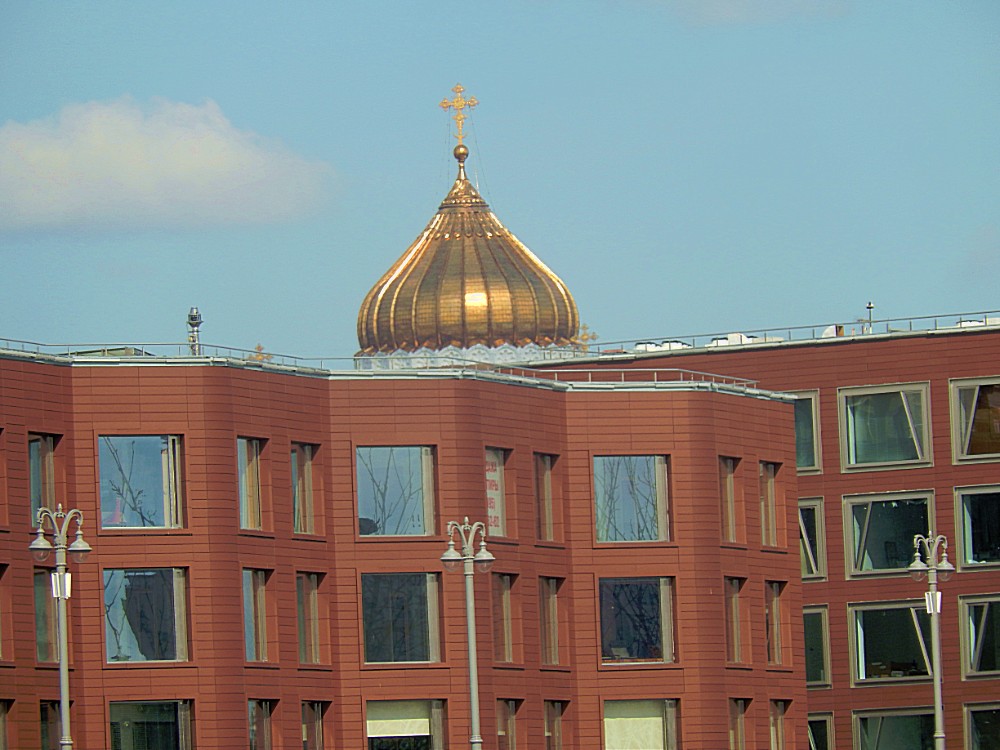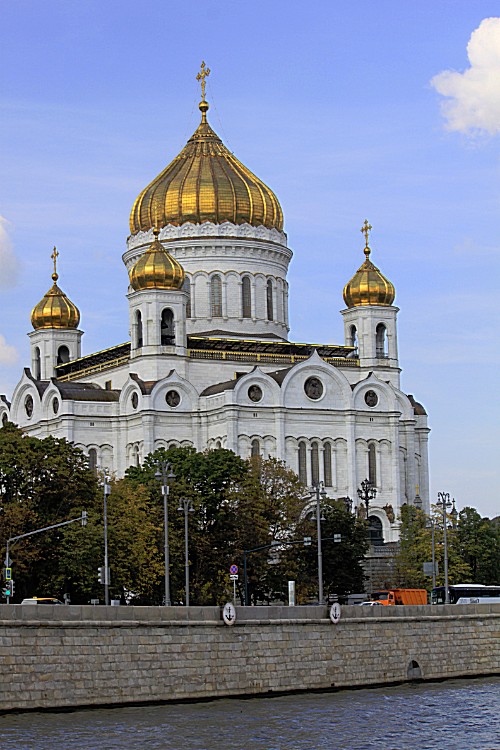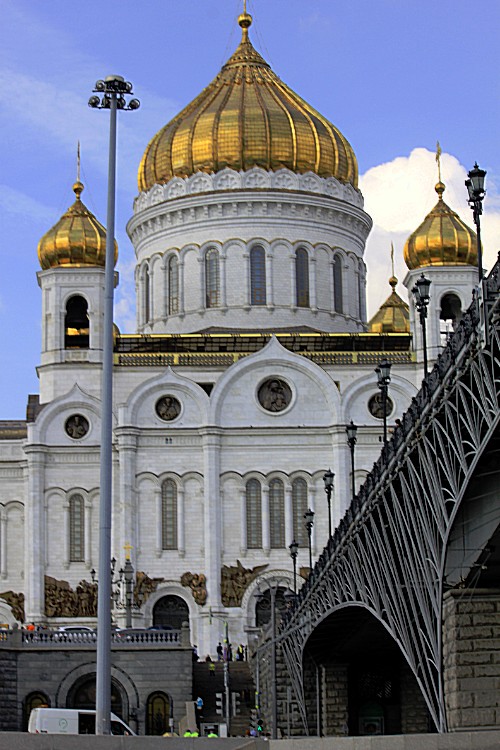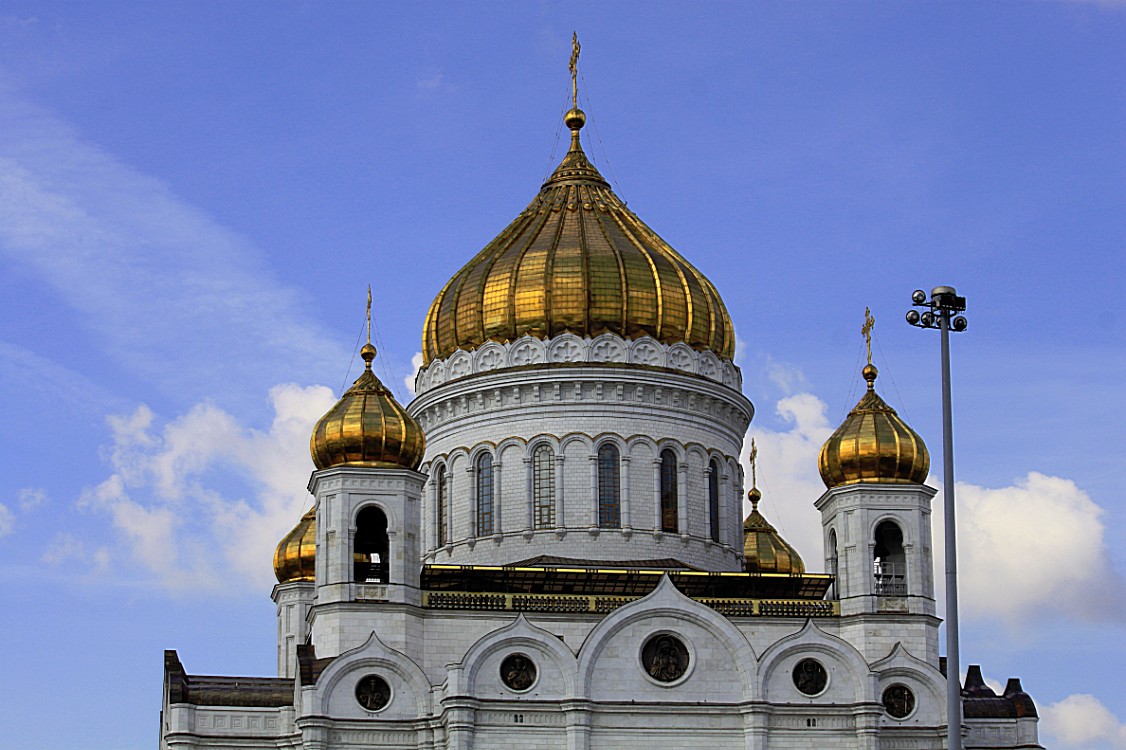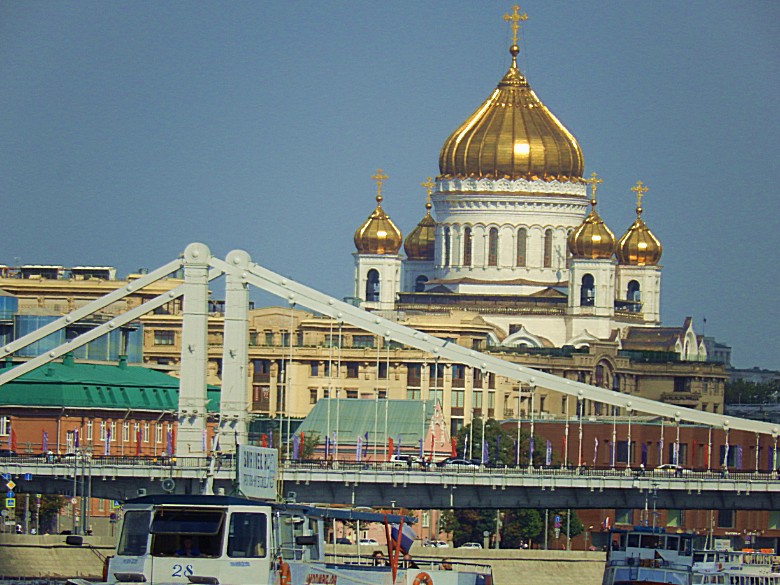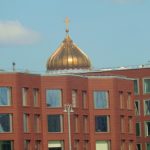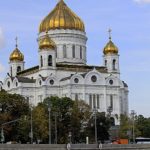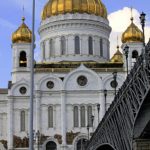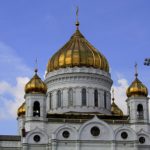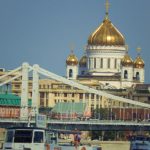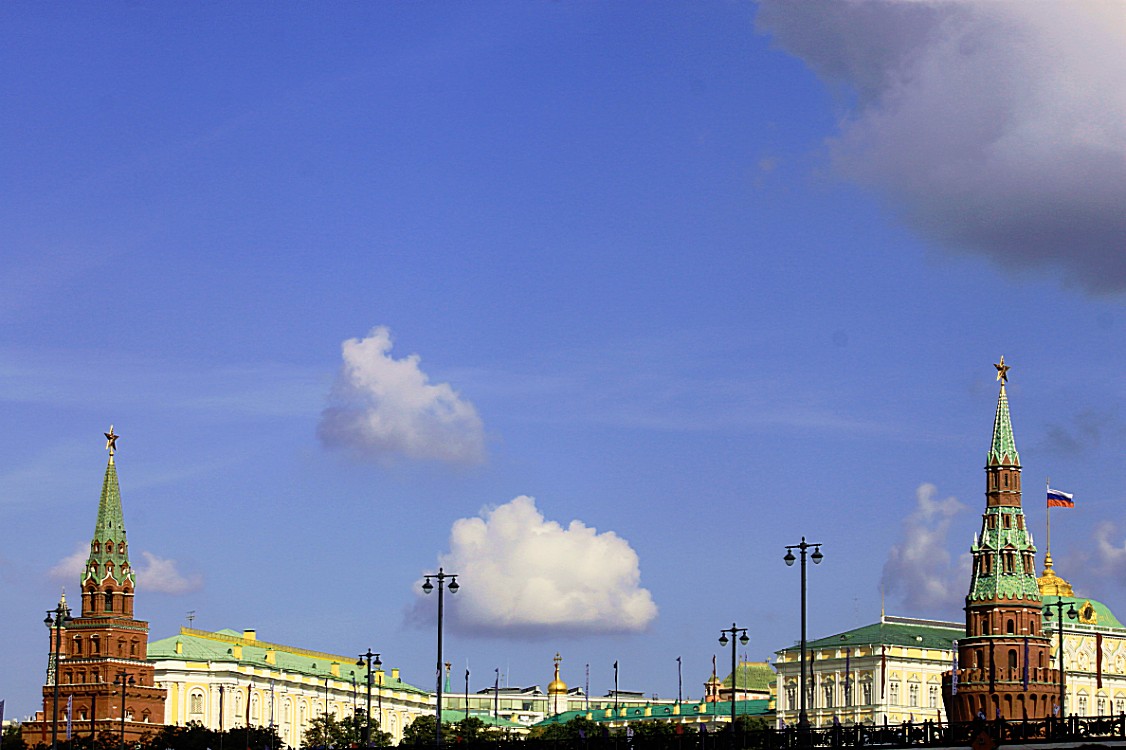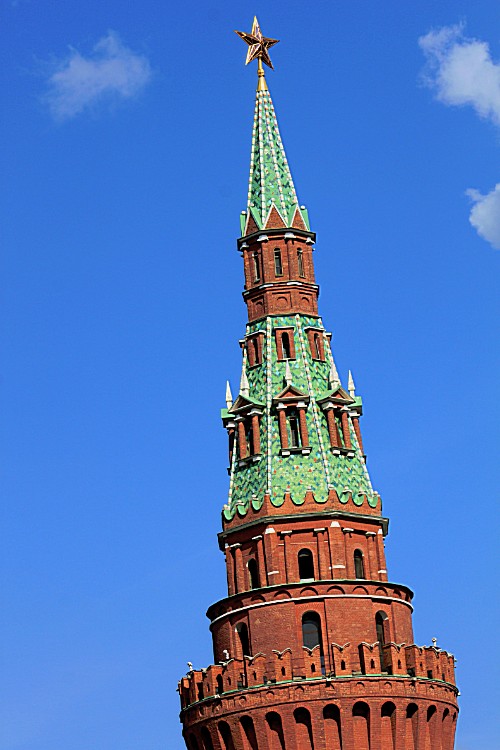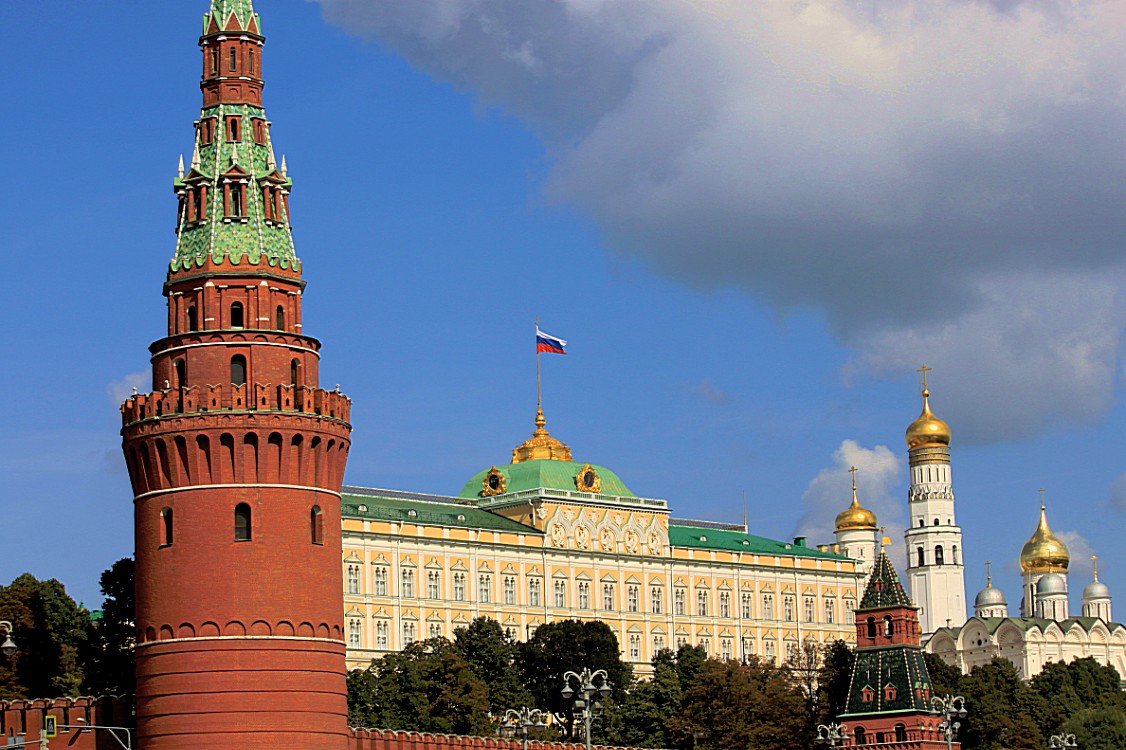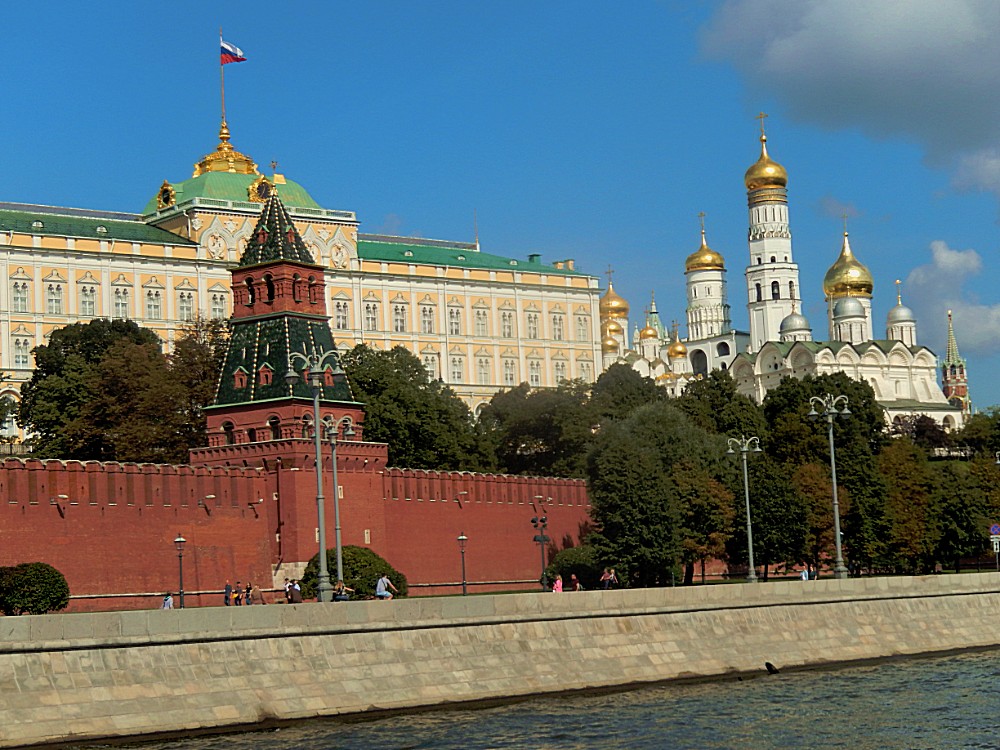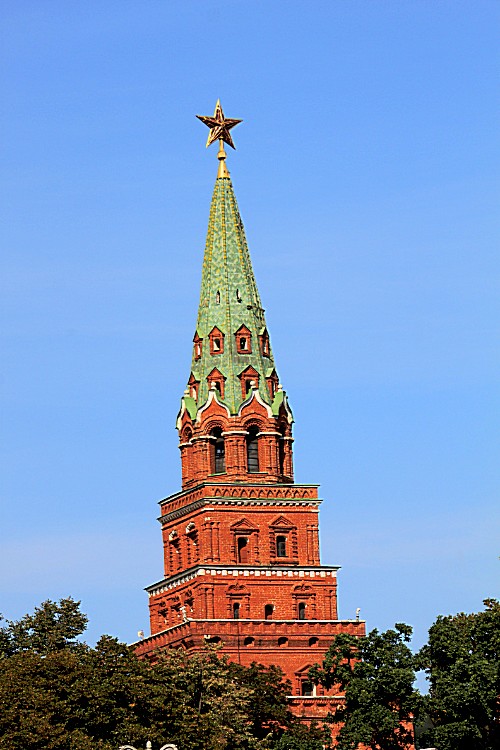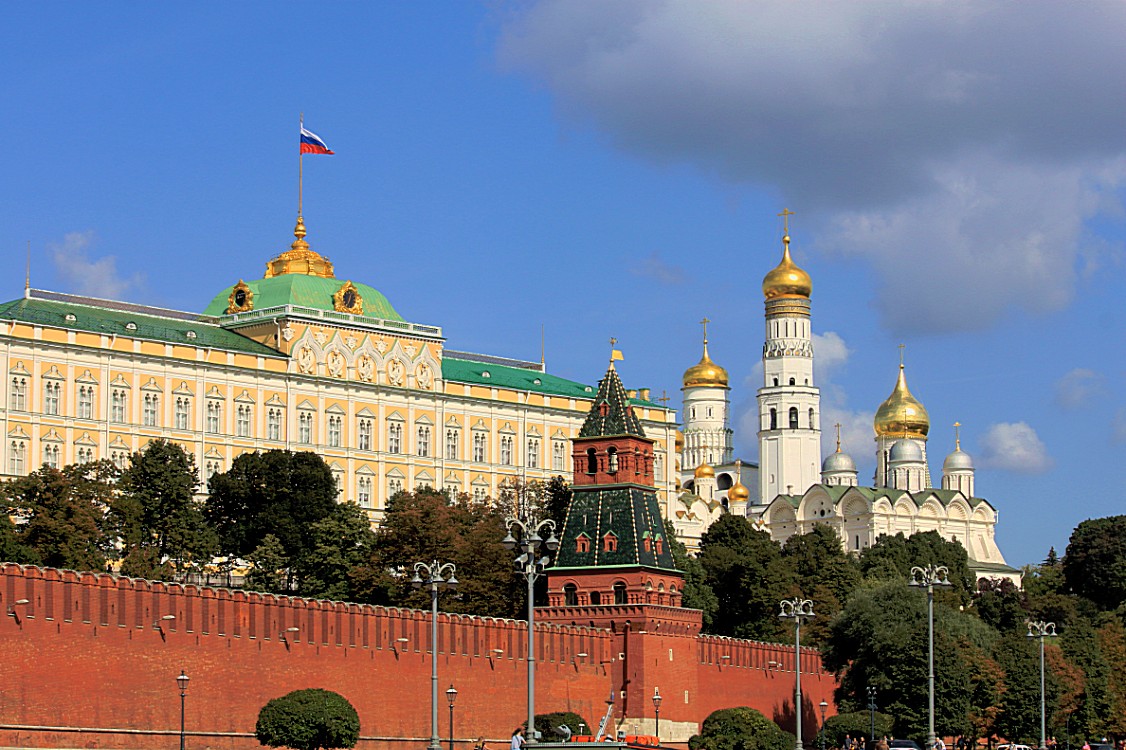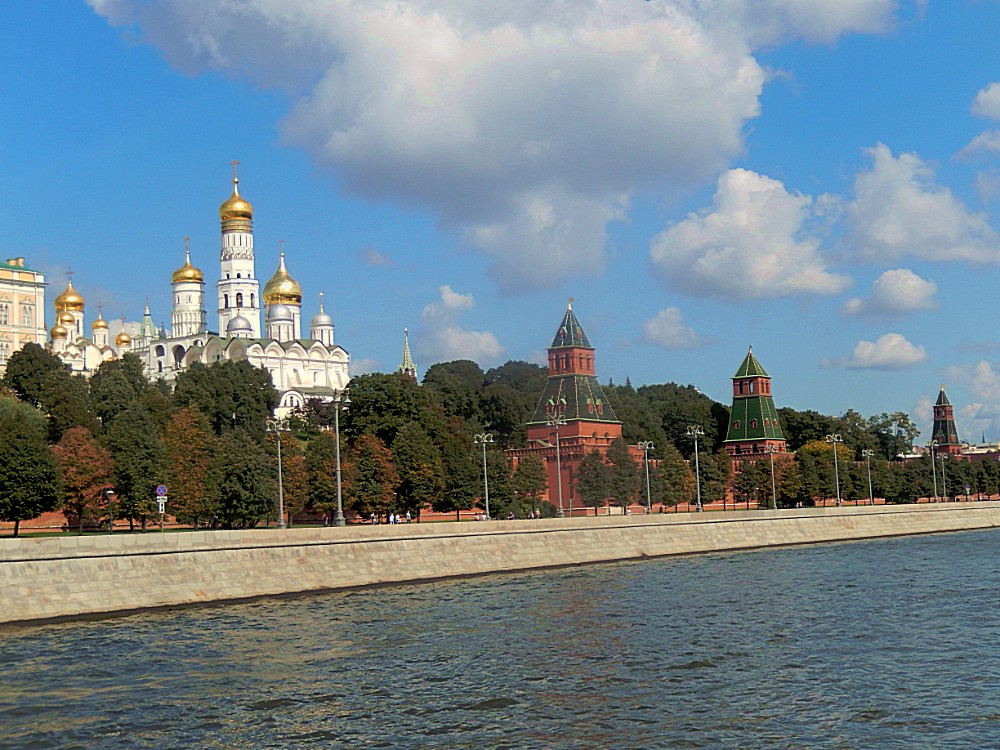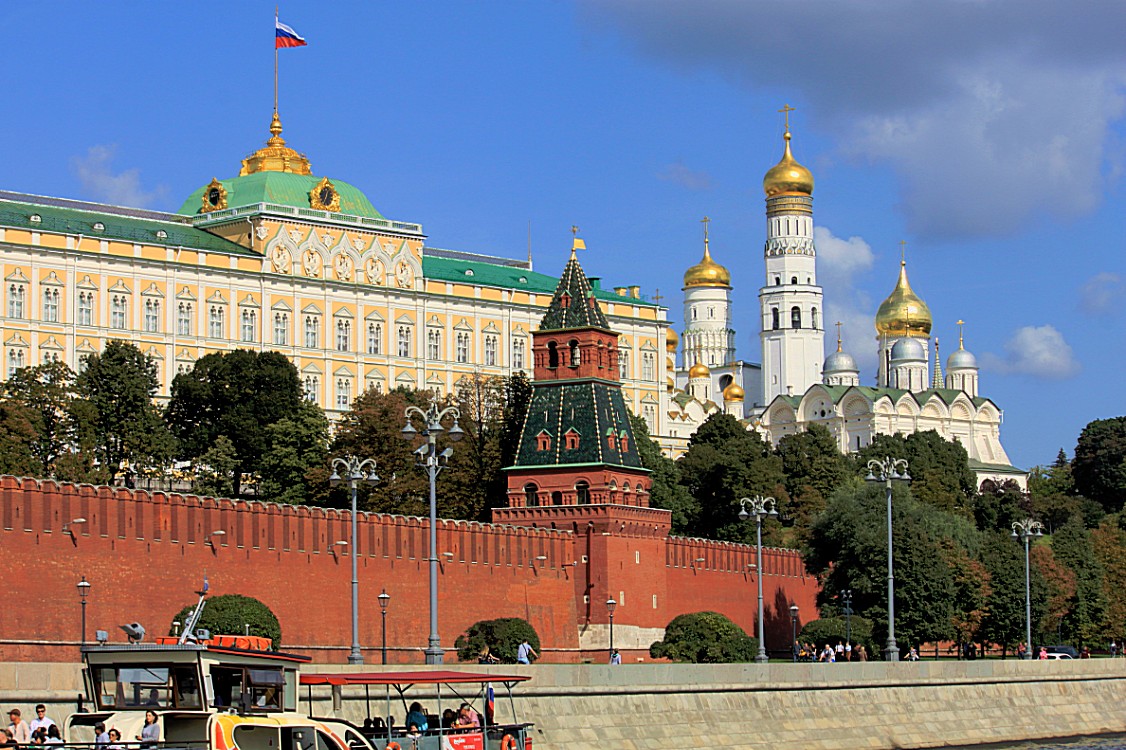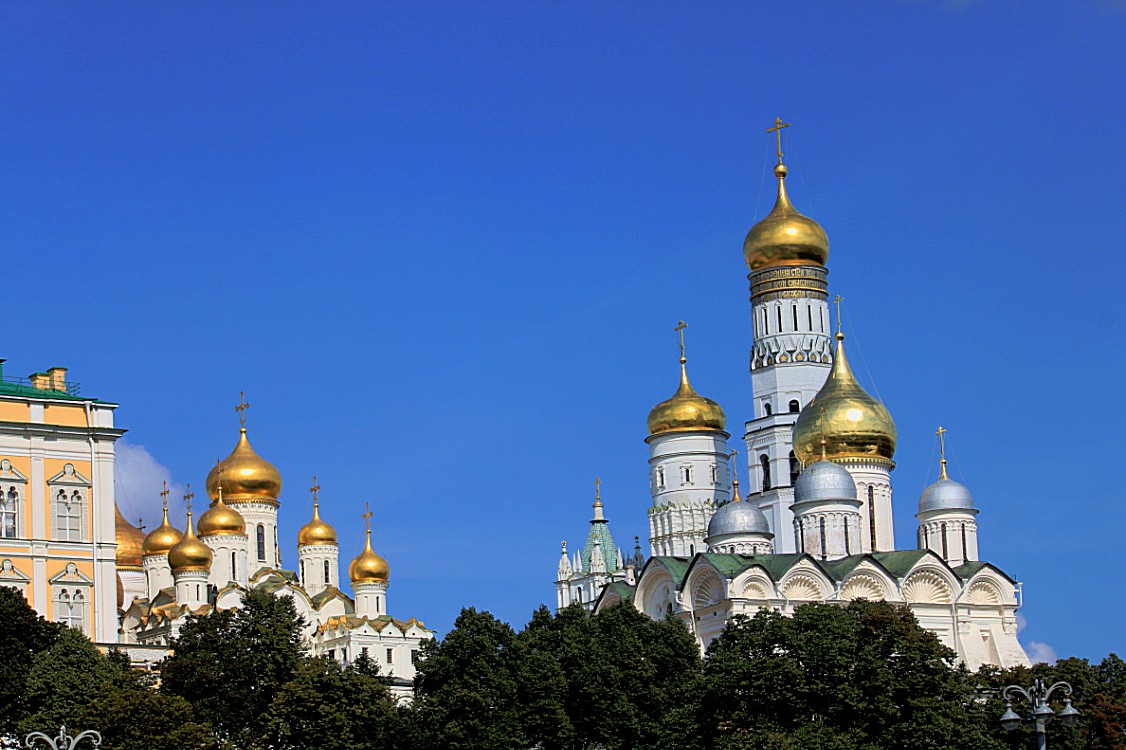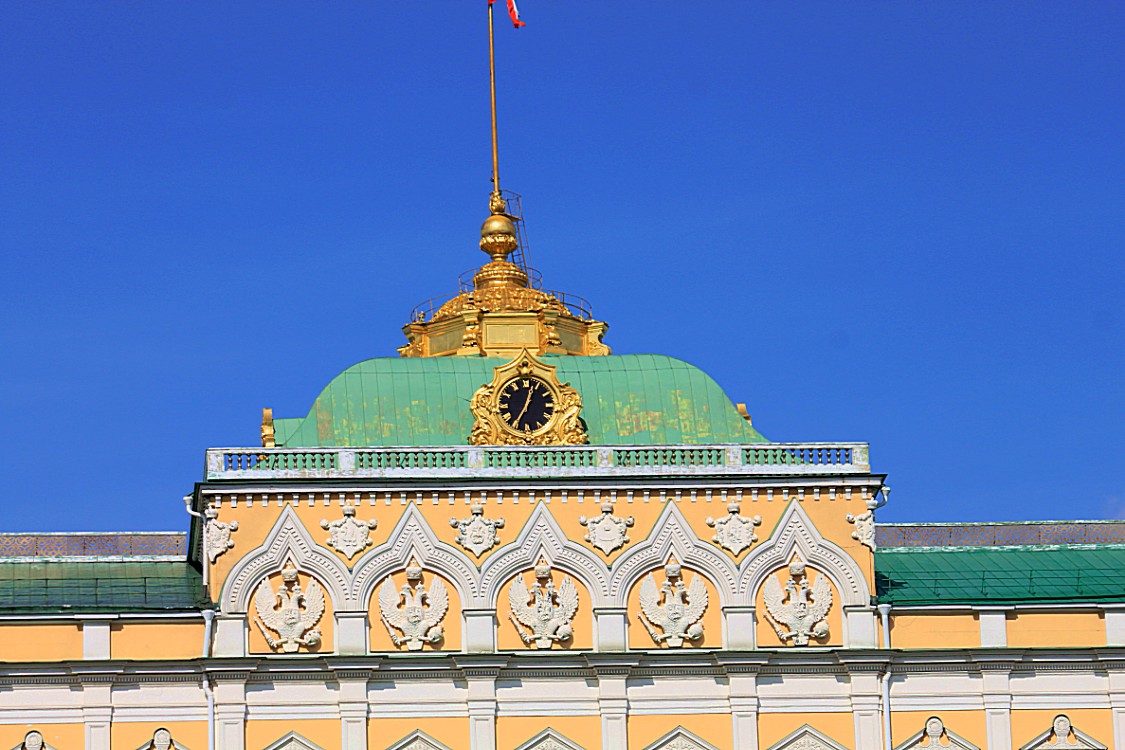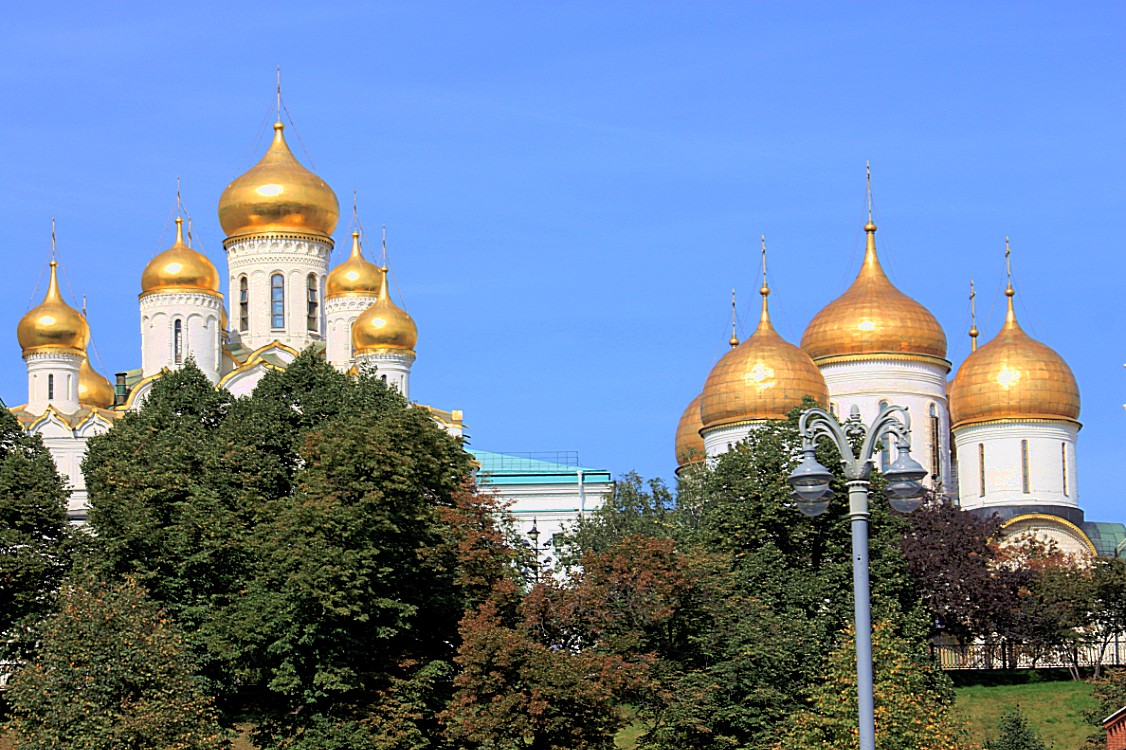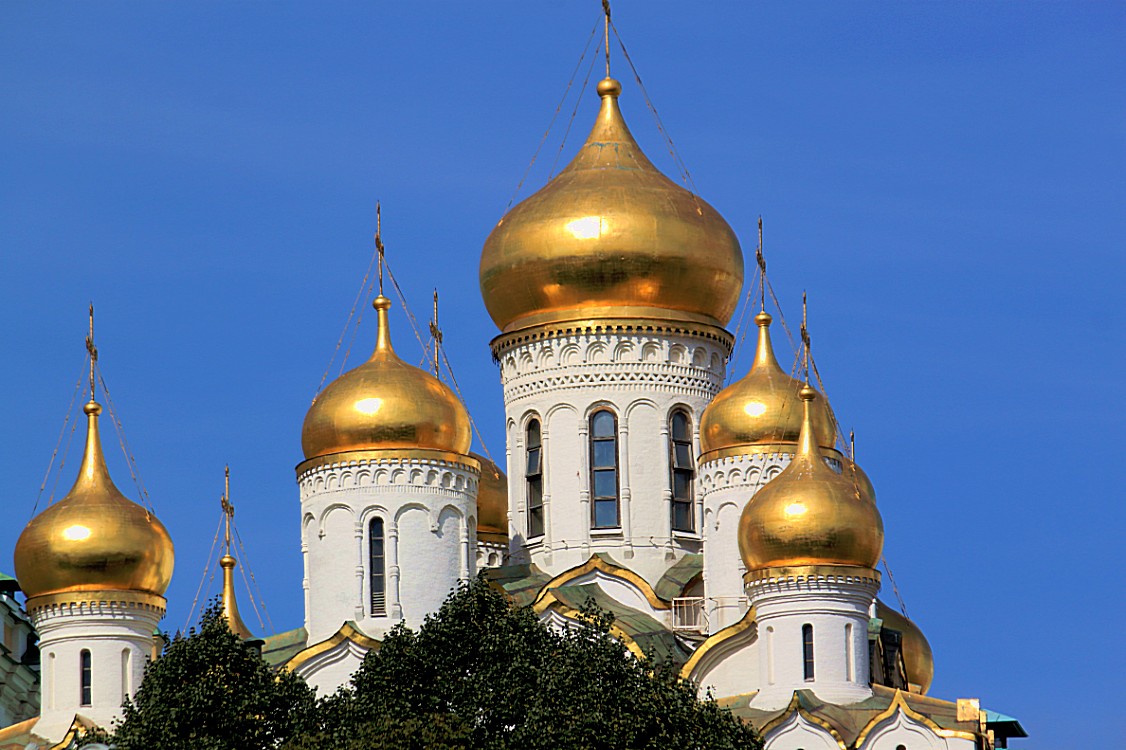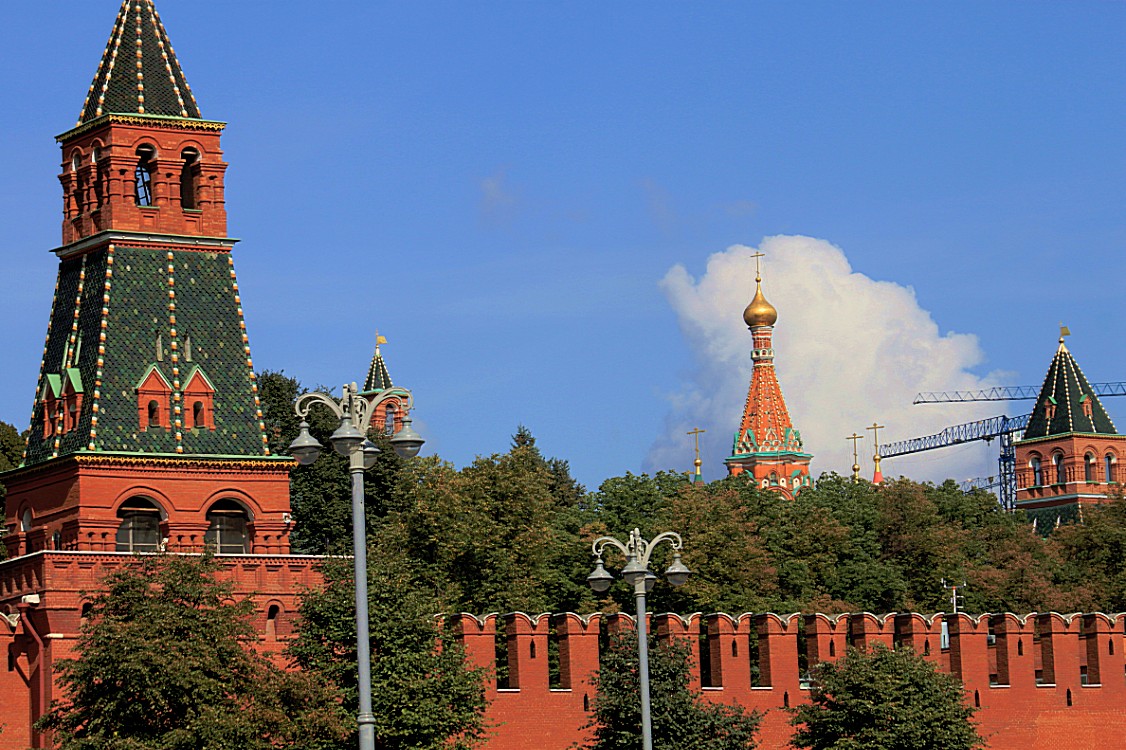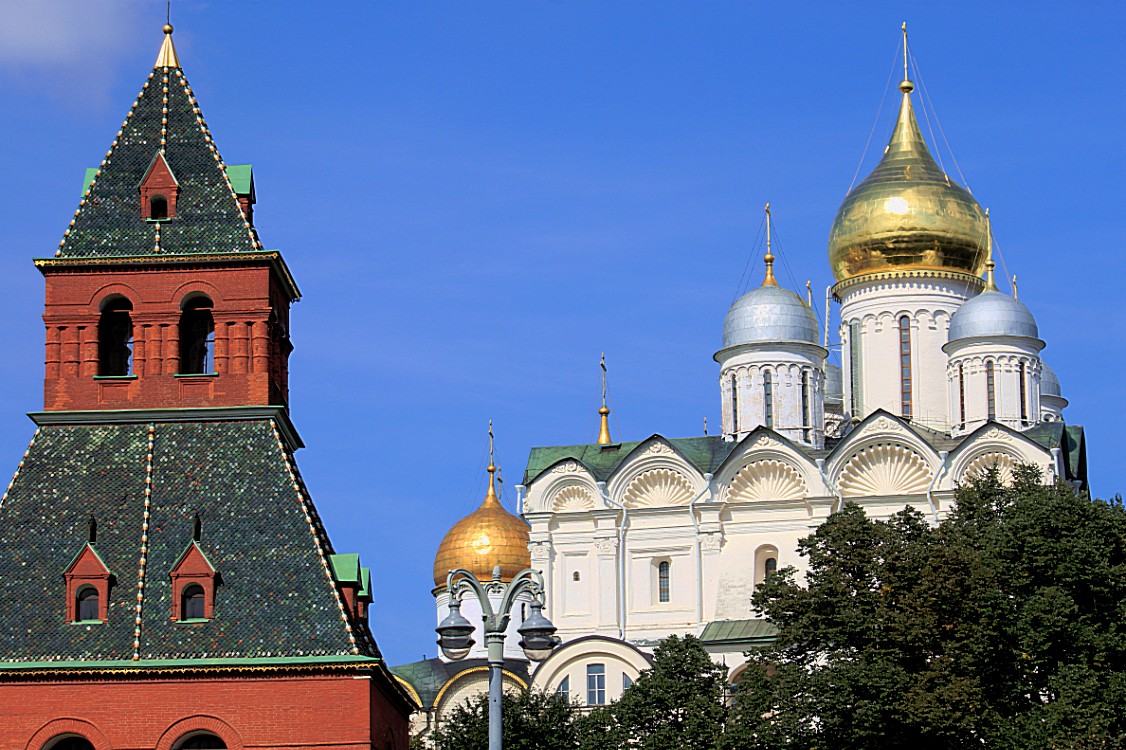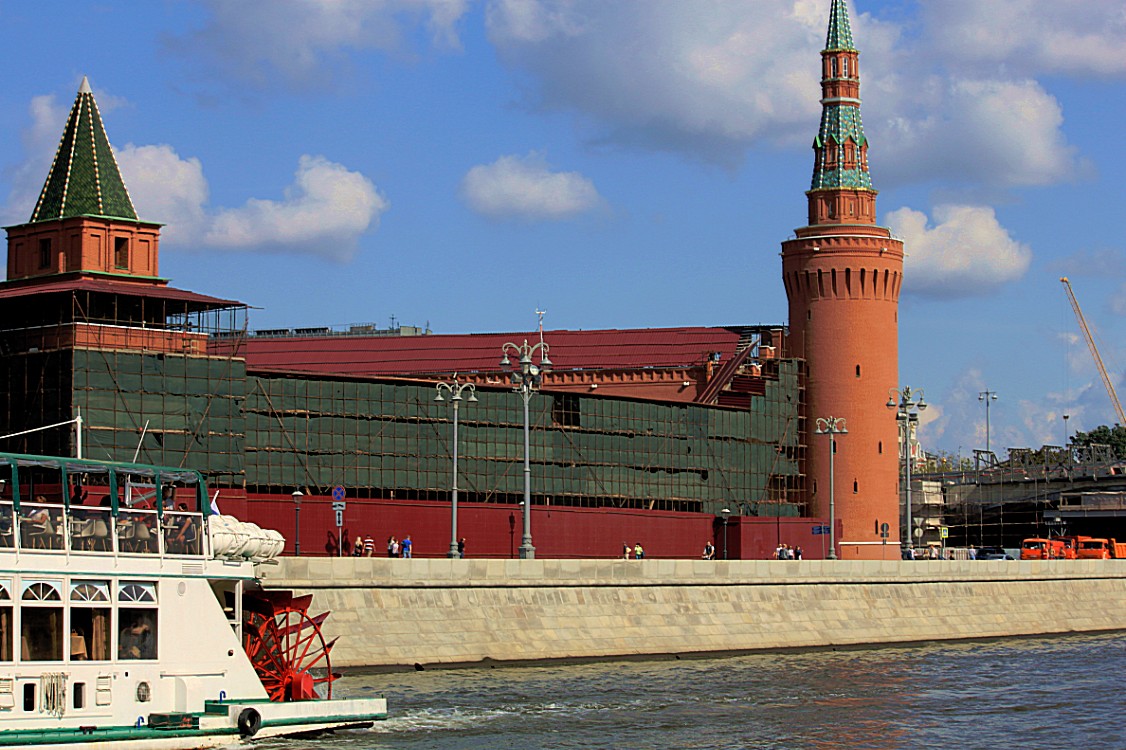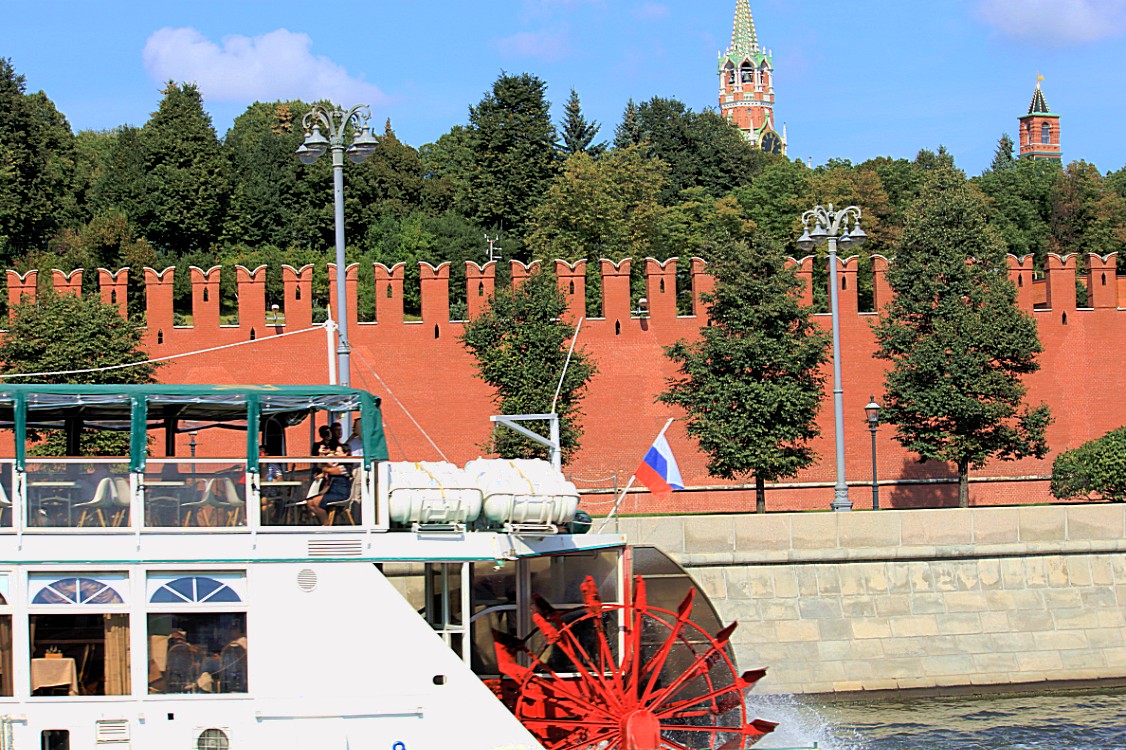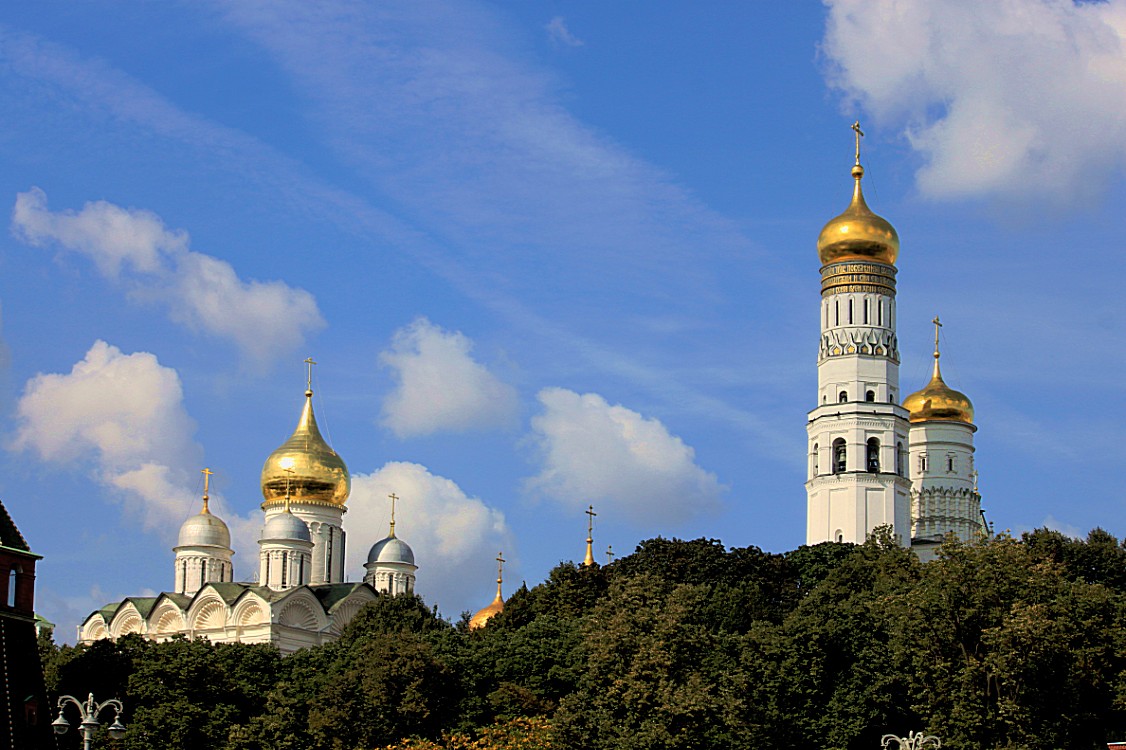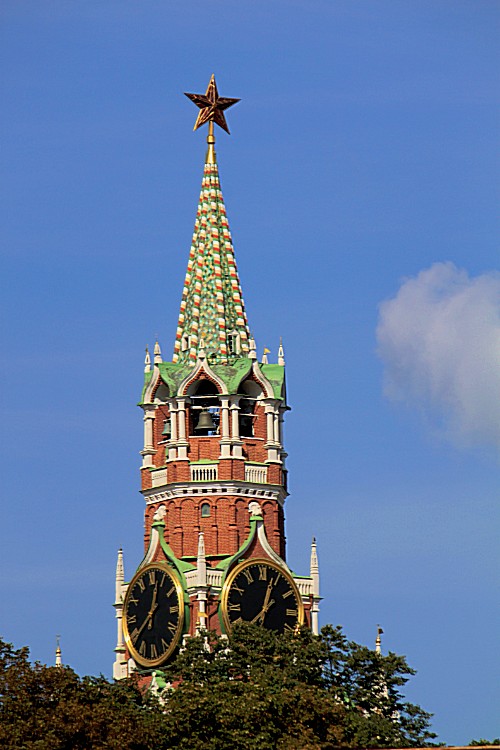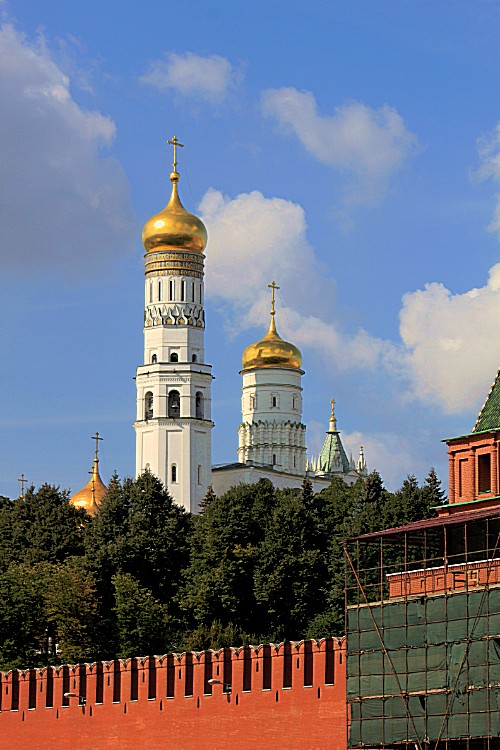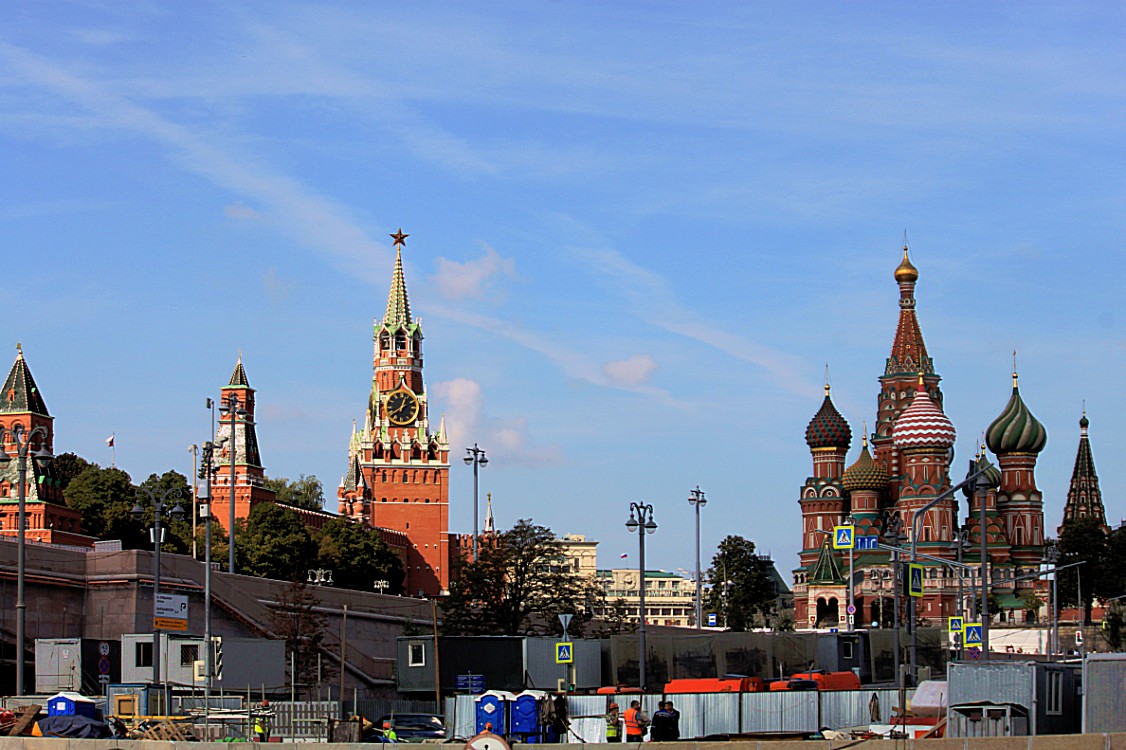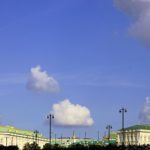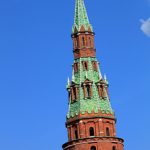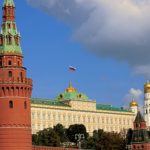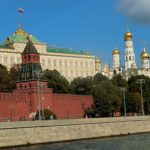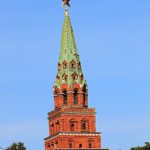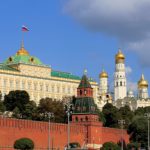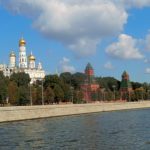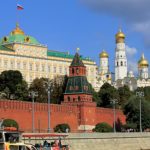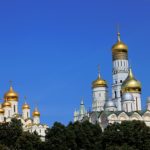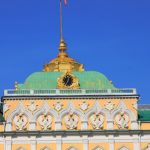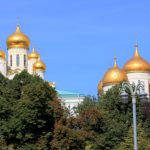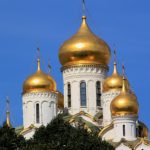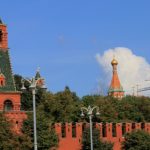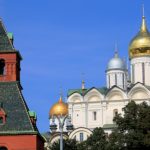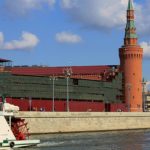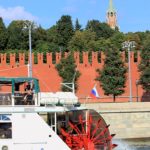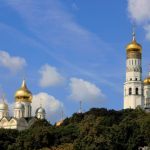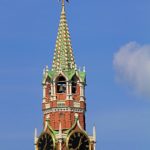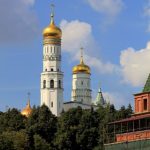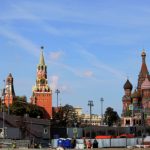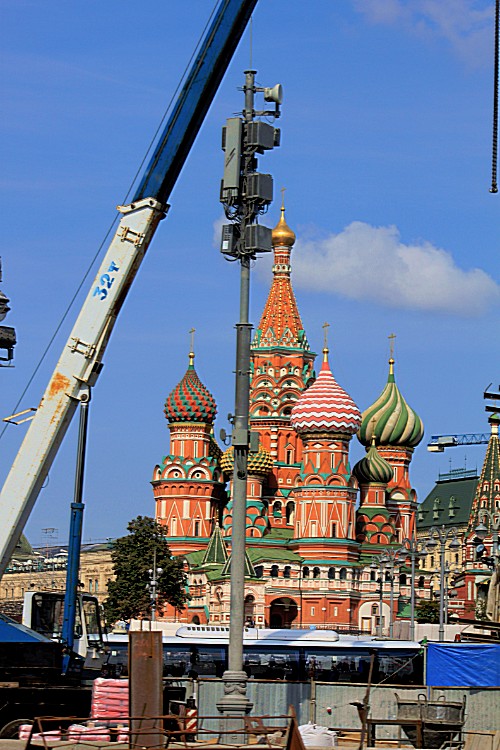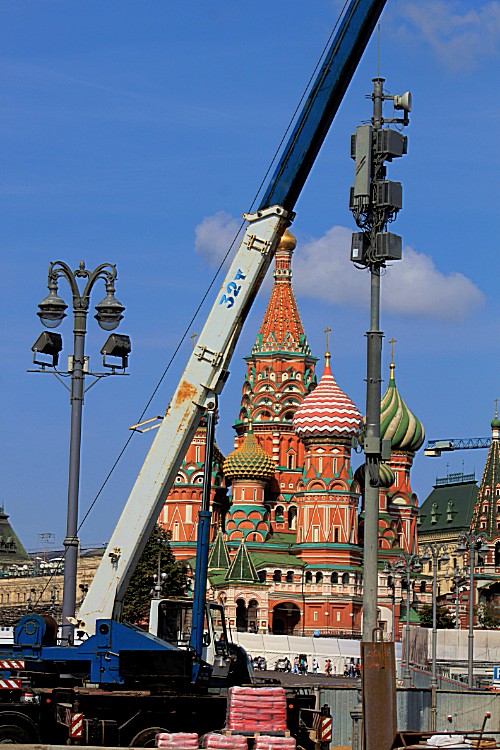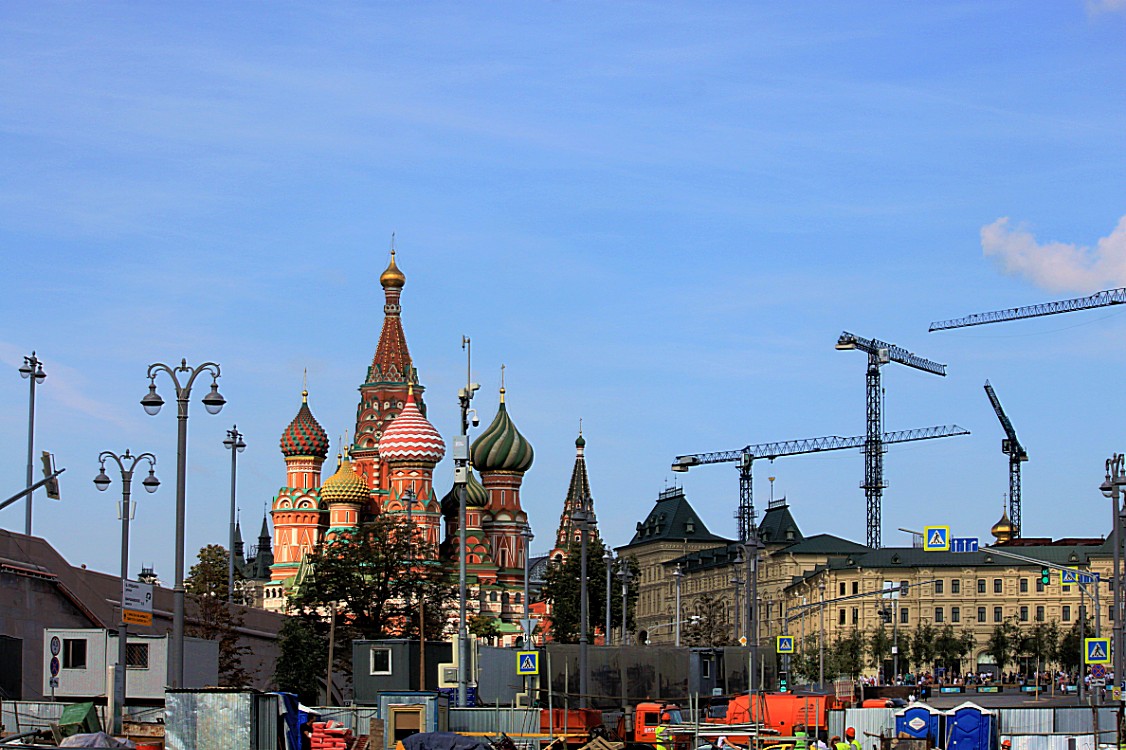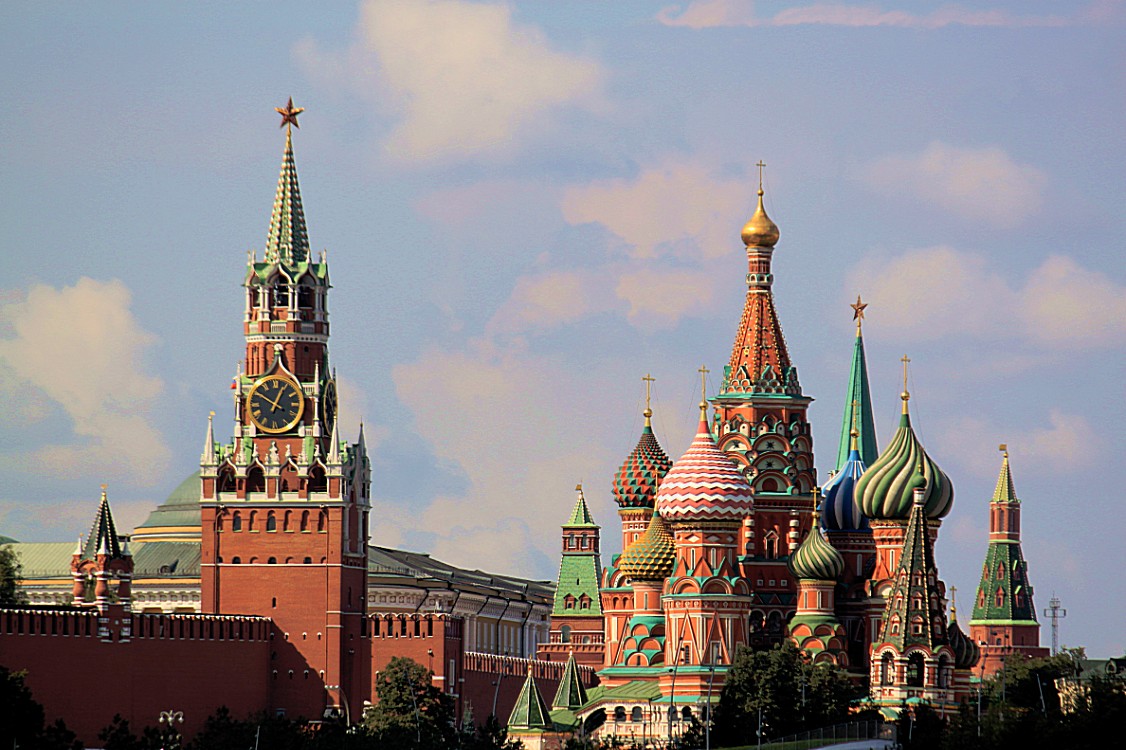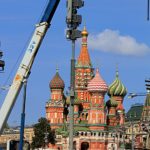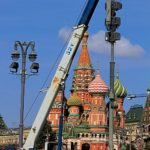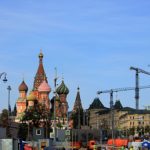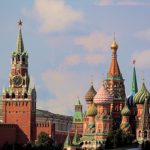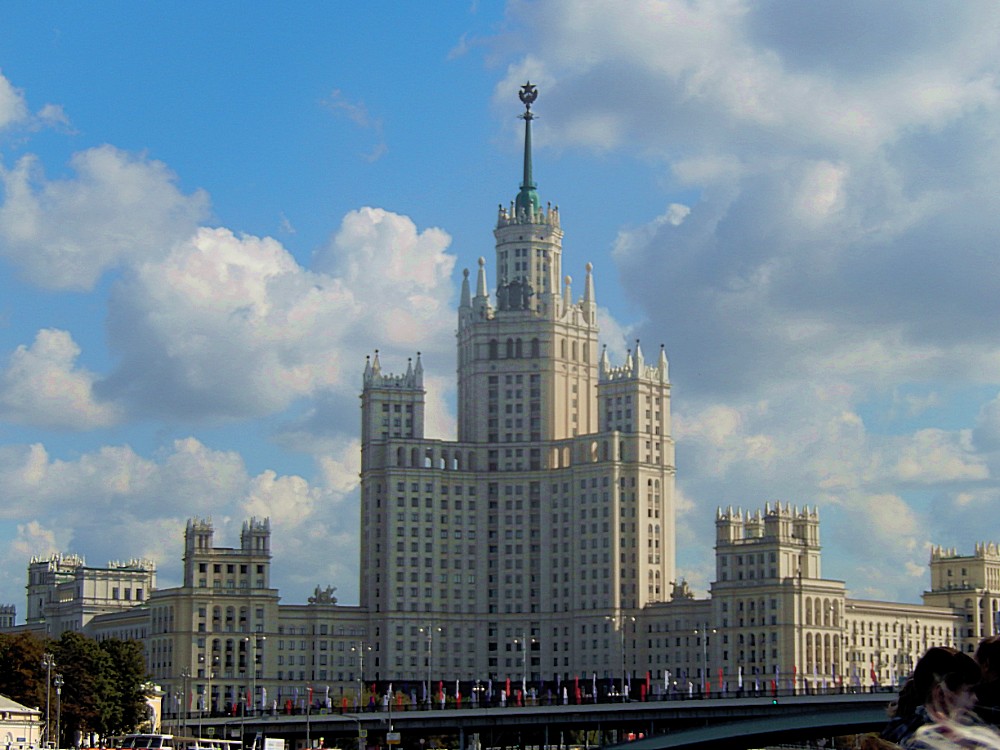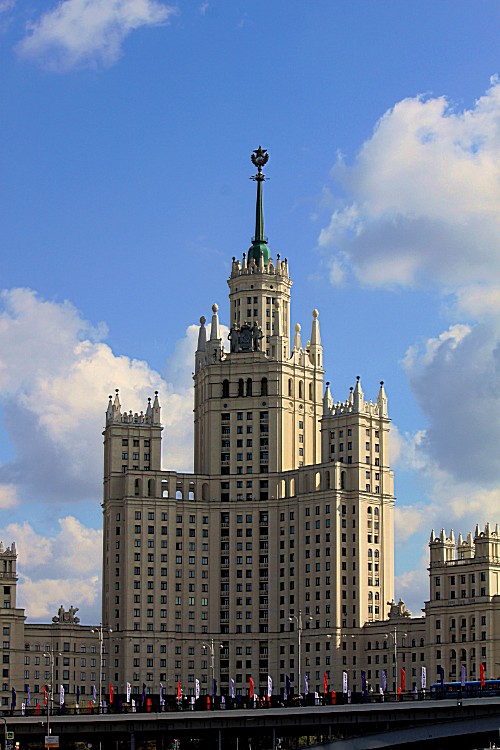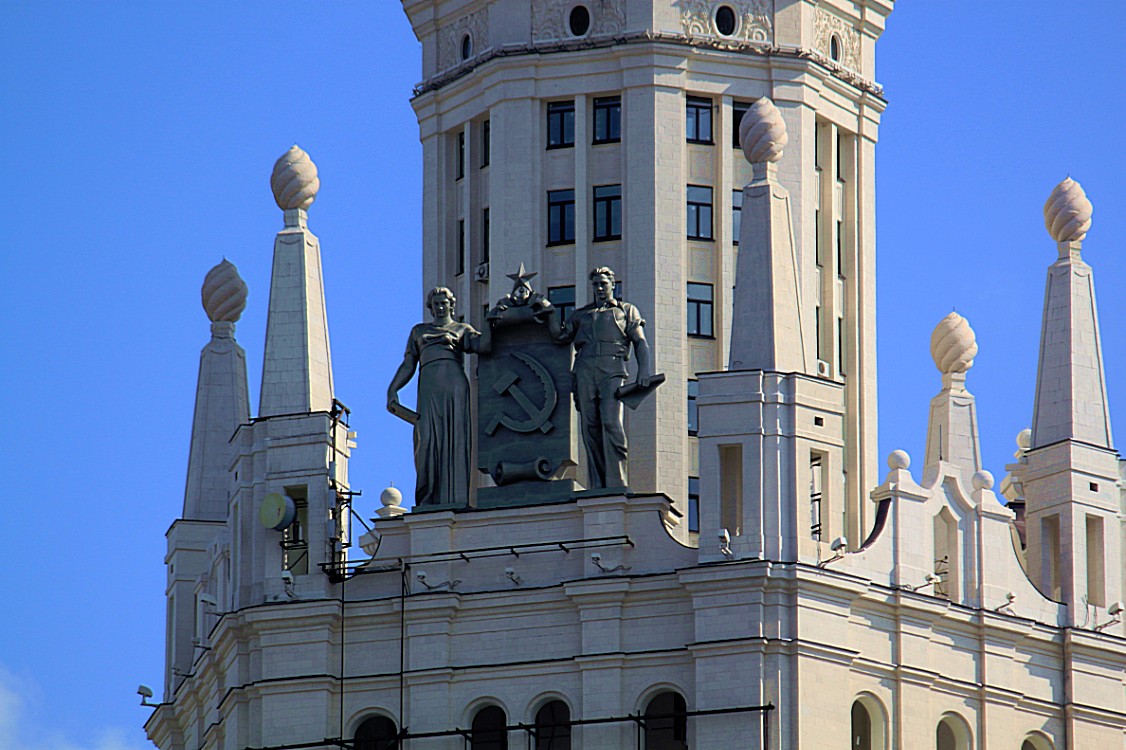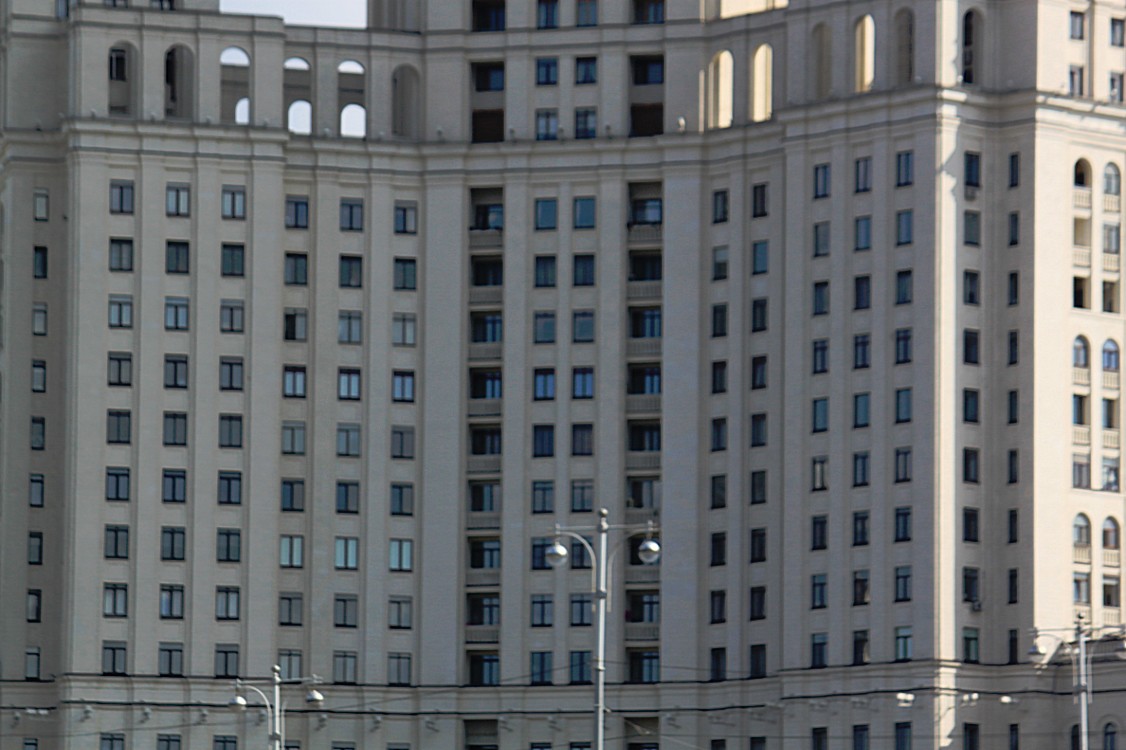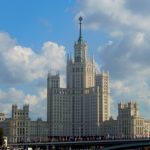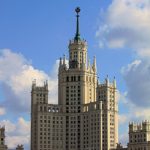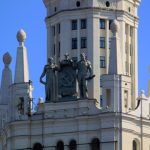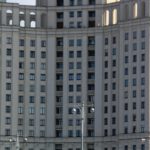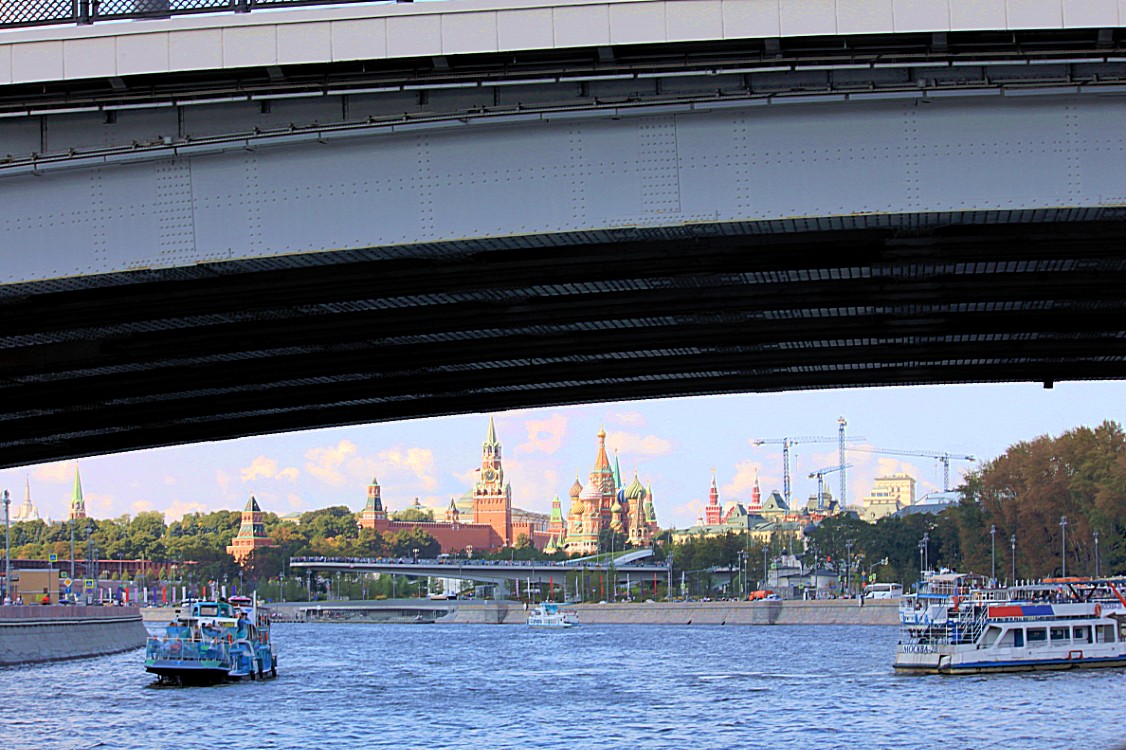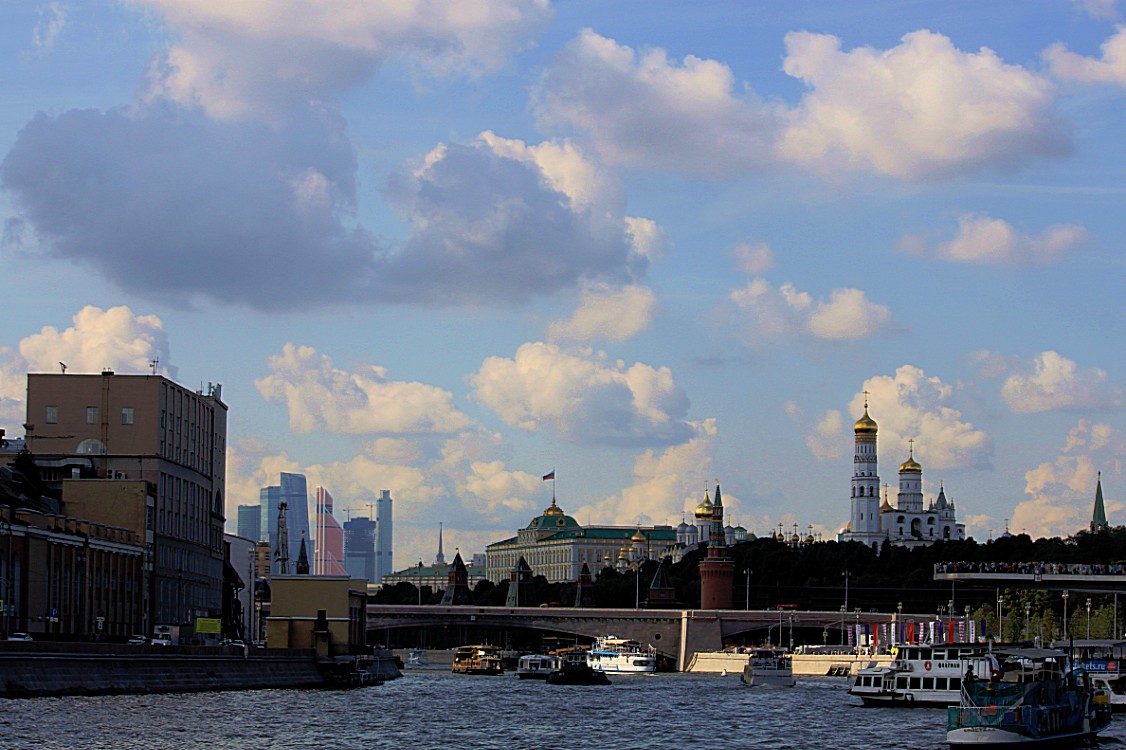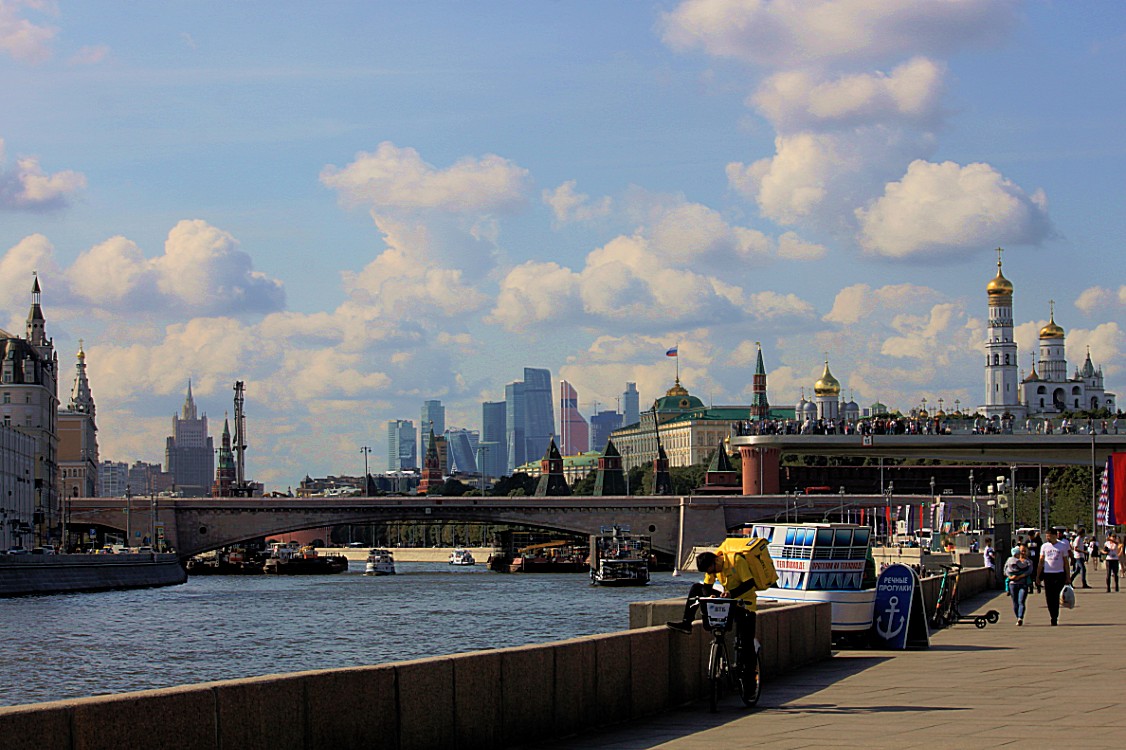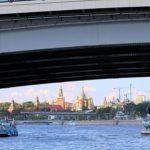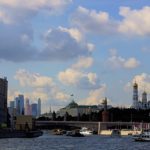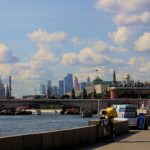Water taxi on the Moskva River
After a morning spent on visiting as much metro stations as possible (see my previous blog about Moscow), The Wandelgek decided to take a boat trip on the River Moscow (Moskva river) to get some fresh air and sun. The Wandelgek ended the metro ride at Kievskaya station.
 The entrance to the station, which is shared with both of the other two Kievskaya stations, is built into the Kiev railway station.
The entrance to the station, which is shared with both of the other two Kievskaya stations, is built into the Kiev railway station.
In front of the station entrance is a large open square from which (looking north/north west) you can clearly see one of the monumental seven Stalinist sisters (more about that later) towering above the green trees of a park. It is Hotel Ukraina.
From there it is a short walk to the River embankment and the start of the boat tours.
From the river embankment you can look south east and see another of the famous seven Stalinist sisters, which is the Moscow State University building.
Also a 2nd Stalinist sister can be seen at the opposite of the river. This is the Ministery of Foreign Affairs.
There are actually two options for a boattrip.
1. The expensive one on a more luxureous boat, including a restaurant on board, which starts at the quay in front of Hotel Arbatskaya (it is not possible to leave this boat during the tour);
2. A budget travel one. Actually it is a watertaxi, which starts at the quay near Kiyevskaya train- and metro station. This one has several stops en route where you are allowed to leave the boat. But of course you can also do a tour using this boat seeing all the Moscow River Front highlights.
The Wandelgek chose the 2nd options
 During the cruise you will see all the major sights of Moscow including: Moscow State University, Hotel Ukraine, Gorky Park, Kremlin, Saint Basil’s Cathedral, Novodevichy Covent and many others. In my opinion it is always nice to see those monuments from a low vantage point which a boat provides.
During the cruise you will see all the major sights of Moscow including: Moscow State University, Hotel Ukraine, Gorky Park, Kremlin, Saint Basil’s Cathedral, Novodevichy Covent and many others. In my opinion it is always nice to see those monuments from a low vantage point which a boat provides.
Route:
 The seven Stalinist sisters
The seven Stalinist sisters

The Seven Sisters (Russian: Сталинские высотки, romanized: Stalinskie Vysotki, lit. ‘Stalin’s high-rises’) are a group of seven skyscrapers in Moscow designed in the Stalinist style. They were built from 1947 to 1953 in an elaborate combination of Russian Baroque and Gothic styles. These towers are inspired by the Municipal Building in Manhattan. At the time of construction they were the tallest buildings in Europe, and the main building of Moscow State University remained the tallest building in Europe until 1997.

The seven are: Hotel Ukraina, Kotelnicheskaya Embankment Apartments, the Kudrinskaya Square Building, the Hilton Moscow Leningradskaya Hotel, the main building of the Ministry of Foreign Affairs, the main building of Moscow State University, and the Red Gates Administrative Building. There were two more skyscrapers in the same style planned that were never built: the Zaryadye Administrative Building and the Palace of the Soviets.
The Wandelgek spotted all 7 from afar, passed 3 very near and visited the interior of 1 of these 7 monumental buildings which are the largests buildings in Russia.
After leaving the embankment, the boat moved towards the first large bend in the river and exactly in that bend was the Moscow State Universities main building which was huge, towering high above lots of green leaved trees…
Moscow State University
Moscow State University (MSU; Russian: Московский государственный университет имени М. В. Ломоносова Moskovskiy gosudarstvenn’y universitet imeni M. V. Lomonosova, often abbreviated МГУ, MGU) is a coeducational and public research university located in Moscow, Russia. It was founded on 23 January [O.S. 12 January] 1755 by Mikhail Lomonosov. During the Soviet period, MSU was renamed after Lomonosov in 1940 and was then known as Lomonosov University. Its current rector is Viktor Sadovnichiy.
Moscow State has educated many notable alumni including leaders of the Soviet Union and other governments as well as a Patriarch of Russian Orthodoxy. It is widely considered the most prestigious university in the former Soviet Union and it is highly competitive. As of 2019, 13 Nobel laureates, 6 Fields Medal winners and 1 Turing Award winner have been affiliated with the university. According to the 2019 QS World University Rankings, it is the highest-ranking Russian educational institution and according to the Nature Index, it is highest ranking Russian university for research output
The main building of Moscow State University (in Russian Гла́вное зда́ние МГУ) is a 240 metres (790 ft) tall, 36-level (in its central part) skyscraper in Moscow, Russia. Designed by Lev Rudnev and completed in 1953, it is utilized as headquarters of the Moscow State University. Built in the Stalinist architectural style, the building is the highest of seven Moscow skyscrapers constructed between 1947 and 1953, and is the tallest educational building in the world. Additionally, from 1953 to 1990 it was also the tallest building in Europe.
The skyscraper has 36 levels in its central part and is 240 metres (790 ft) tall. Its roof (182 metres (597 ft)) is topped by a 57-metre spire which ends with a 12-ton five-pointed star. Lateral towers are lower than the central one; two 18 and 9 storey dormitory wings define, with the central corpus of the complex, a cour d’honneur courtyard.
Among the statues which decorate the building is a sculpture by Vera Muchina representing a couple of students and a statue by N. Tomsky of Mikhail Lomonosov (1711–1765), the founder of Moscow University. The University premises cover around 1.6 square kilometres. The complex was partially renovated in 2000.
The Main Building of Moscow State University is not open to the general public. Visitors from outside the university must be pre-approved by their university host and must submit their domestic passport (Russian) or international passport in order to gain entry.
After passing underneath some bridges and the 1st bend in the river, the boat approached a somewhat awkward covered bridge…
Luzhnetskiy Most
 Luzhniki Metro Bridge (Russian: Лужнецкий метромост), also known as Metromost (Метромост), is a concrete double-decked (two-level) arch bridge carrying a road and a Moscow Metro line across the Moskva River in Moscow, Russia. It connects the neighbourhood of Luzhniki Stadium to Sparrow Hills. The bridge houses Vorobyovy Gory, the only station of Moscow Metro located over water. Designed in 1958 by V.G. Andreyev and N.N. Rudomasin (structural engineering), the bridge rapidly decayed and was rebuilt in 1997–2002.
Luzhniki Metro Bridge (Russian: Лужнецкий метромост), also known as Metromost (Метромост), is a concrete double-decked (two-level) arch bridge carrying a road and a Moscow Metro line across the Moskva River in Moscow, Russia. It connects the neighbourhood of Luzhniki Stadium to Sparrow Hills. The bridge houses Vorobyovy Gory, the only station of Moscow Metro located over water. Designed in 1958 by V.G. Andreyev and N.N. Rudomasin (structural engineering), the bridge rapidly decayed and was rebuilt in 1997–2002.
Another awkward bridge appeared on the horizon and as the boat approached it it seemed to be a constellation of different architectural styles…
Pushkinskiy bridge
Andreyevsky Bridge (Russian: Андреевский мост, St. Andrew’s Bridge) name refers to a historical bridge demolished in 1998 and three existing bridges across Moskva River, located between Luzhniki and Gorky Park in Moscow.
0.Andreyevsky Rail Bridge (1907, demolished 1998)
The original Sergievsky Bridge (Сергиевский мост), named after the late Grand Duke Sergei Alexandrovich, and its twin, Nicholas II Bridge (Мост Николая II, later Krasnoluzhsky Bridge) were built in 1903-1907, replacing temporary wooden truss bridges of the Moscow Inner Ring Railroad. New bridges were designed as through arch bridges by Lavr Proskuryakov (structural engineering) and Alexander Pomerantsev (architectural design). 0he 135 meter wide, 15 metre tall steel arch (1400 metric tons) was made at Votkinsk works. Proskuryakov’s work, considered a marvel of engineering, was proven by the 1908 flood: water level exceeded the maximum design specification by a metre and a half; the bridges stood unharmed.
After the February Revolution of 1917, Romanov names were erased from the map. Sergievsky Bridge was renamed Andreyevsky after nearby St.Andrew’s monastery, Nicholas II Bridge became Krasnoluzhsky Bridge.
In 1937, the arched stone pillars over embankments were extended from one to two spans (each side) to accommodate increased street traffic. A similar reconstruction of Krasnoluzhsky Bridge was completed in 1956.
The bridge was still in good order when it was demolished to make way for the construction of the Third Ring highway. Space limitations required vertical and horizontal realignment of track (1.5 metres up and 22 metres downstream), so the whole rail bridge (arch, roadway and pillars) had to be rebuilt on a new site (unlike Krasnoluzhsky bridge, which retained its pillars). Demolition (actually, careful disassembly) began in April 1998.
1. Pushkinsky Pedestrian Bridge (2000)
Instead of scrapping the steel arch of the 1907 Andreyevsky Rail Bridge, city planners re-used it as a structural core for the new pedestrian bridge. May 22, 1999, three barges towed the steel frame to the new anchorage, 1.5 kilometre downstream. By this time, contractors already set up concrete foundations, pillars and arches at the new site; they were finished with granite slabs salvaged from the old site. Moskva river at this point is wider than at St.Andrew’s, so four pillars and three 25-meter arches over water were required to close the gaps.
Pushkinsky bridge connects First Frunzenskaya street in Khamovniki (left bank) with the southern edge of Gorky Park and Titovsky Proezd leading to Leninsky Avenue (right bank). Design team was led by Yu.P.Platonov. Main pedestrian walkway and stairs are completely enclosed in a glass canopy; there are two open-air side walkways. Left bank entrance has a two-lane escalator. On the right bank, the main flat walkway extends 240 metres past the pillars through the park.
2. Andreyevsky Rail Bridge (2001)
Initially, rail bridge completion had a higher priority and a 15-month fast track schedule, but in real life priorities changed, and the new road bridge was completed first. Both jobs required removal of old rail bridge, which was done May 22, 1999 after 11 months of preparation. Rail service of the Inner Ring was suspended for two years until completion in 2001.
New steel arch (engineer S.S.Tkachenko) is superficially similar to Proskuryakov’s original design; it is now 21.5 metre tall, with a higher track alignment; width remains the same, 135.0 metres. The bridge has only one (upstream) pedestrian walkway and two copies of four original obelisks.
3. Andreyevsky Road Bridge (2000)
New Andreyevsky Road Bridge (Aндреевский автодорожный мост) was completed in December 2000. Design challenge included merging the bridge with the tunnel system under Gagarin Square. Significant incline of roadway ruled out the box girder style in favor of concrete truss arch bridge (lead designer E.G.Gapontsev), set on a 32-metre deep pile foundation. The arch is 135 meters wide and 15 meters high; 39-meter wide roadway has 8 lanes for regular traffic and a single pedestrian and bicycle walkway.
An effective and economical solution, however, failed to preserve visual coherence of two adjacent bridges; new structure completely obstructs the fine outline of Proskuryakov’s classic .
Immediately passed this composition of bridgeswas another impressive building housing the:
Ministery of Defence of the Russian Federation
Main Building of the Ministry of Defense (Russia)
The Main Building of the Russian Defense Ministry is the headquarters of the Russian Ministry of Defense, located in Moscow, Russia.
The building was designed by Russian architect Lev Rudnev and was renovated by Mikhail Posokhin who was the main architect of Moscow (1960–1982). Ground was broken for construction on 1940, and the building was dedicated on 1952.
The main ministry building, built in the 1940s and renovated in the 1980s, is located on Arbatskaya Square, near Arbat Street. Other buildings of the ministry are located throughout the city of Moscow. The high supreme body that responsible for the Ministry’s management and supervision of the Armed Forces is The National Defense Management Center (Национальный центр управления обороной РФ) which is located in Frunze Naberezhnaya and responsible for centralization of the Armed Forces’ command.
The building has eight floors. The walls are decorated with marble, Ural stones: serpentine and granite
The boat was approaching Gorki Park to the right. I always sais to myself that I needed to visit this park whenever I would be visiting Moscow, because I once saw this cold war themed espionage movie baring the park’s name which really captivated my mind. It was a thriller and although most of the movie was actually filmed in Finland and Sweden…
Gorky Park
Gorky Central Park of Culture and Leisure, is a central park in Moscow, named after Maxim Gorky. In August 2018, the Park’s 90th anniversary was celebrated.
You could not see very much of the park from the boat though. A bit further, the Moskva river starts to divide itself around a large island and at the bow of that island was a large very high statue of a wooden sail ship, sailing into the Moskva river and at its bow stood a large figure of Tsar Peter the Great looking over the water in front of him…
Peter the Great Statue
The Peter the Great Statue is a 98-metre-high (322 ft) monument to Peter the Great, located at the western confluence of the Moskva River and the Vodootvodny Canal in central Moscow, Russia. It was designed by the Georgian designer Zurab Tsereteli to commemorate 300 years of the Russian Navy, which Peter the Great established. It was erected in 1997 and is the eighth-tallest statue in the world. It weighs around 1,000 tons and contains 600 tons of stainless steel, bronze and copper.
History
Since its inception, the statue has courted controversy. In November 2008, it was voted the tenth ugliest building in the world by Virtual Tourist. In 2010, it was included in a list of the world’s ugliest statues by Foreign Policy magazine. Lonely Planet commented: “Questions of taste aside, Muscovites were sceptical about the whole idea: why pay tribute to Peter the Great, who loathed Moscow and moved the capital to St Petersburg?”
The designer Zurab Tsereteli is known as a friend and favorite of Moscow’s former Mayor Yury Luzhkov, and the artist received a number of municipal art commissions under his patronage, such as the Cathedral of Christ the Savior, the Manege Square ensemble and the War Memorial Complex on Poklonnaya Gora. In October 2010, following Luzhkov’s departure from office, Moscow authorities, reportedly keen to get rid of the Peter the Great Statue, offered to relocate it to Saint Petersburg, but this offer was refused by the city. Authorities in Arkhangelsk and Petrozavodsk have offered to accept the monument.
The statue is allegedly based on a design originally intended to commemorate the 500th anniversary of the first voyage of Christopher Columbus in 1992. When an American customer for the project could not be found, it was re-purposed with a Russian theme. Tsereteli denies this story.
A separate, equally colossal statue of Columbus, known as Birth of the New World, by the same designer was constructed in Puerto Rico in 2016, after being rejected by various US cities. The statue was unveiled in the city of Arecibo on 14 June 2016. A somewhat smaller but similar sculpture by Tsereteli, Birth of a New Man, was deposited in Seville.
The boat kept the island to the right and now we passed an interesting architectural art nouveau house block.
Dom Pertsovoy
The fairy-tale-like House of Pertsova (DOM PERTSOVOY), is a Moscow art nouveau building
The Wandelgek now saw the golden dome of the famous Christ the Saviour cathedral peek over some modern appartment blocks…
Christ the Saviour cathedral
When Napoleon Bonaparte retreated from Moscow, Tsar Alexander I signed a manifesto on 25 December 1812 declaring his intention to build a cathedral in honor of Christ the Savior “to signify Our gratitude to Divine Providence for saving Russia from the doom that overshadowed Her” and as a memorial to the sacrifices of the Russian people.
The Cathedral of Christ the Saviour is a Russian Orthodox cathedral in Moscow, Russia, on the northern bank of the Moskva River, a few hundred metres southwest of the Kremlin. With an overall height of 103 metres (338 ft), it is the second tallest Orthodox Christian church in the world, after the People’s Salvation Cathedral from Bucharest, Romania.
The current church is the second to stand on this site. The original church, built during the 19th century, took more than 40 years to build, and was the scene of the 1882 world premiere of the 1812 Overture composed by Tchaikovsky. It was destroyed in 1931 on the order of Soviet leader Joseph Stalin. The demolition was supposed to make way for a colossal Palace of the Soviets to house the country’s legislature, the Supreme Soviet of the USSR. Construction started in 1937 but was halted in 1941 when Germany invaded the Soviet Union during World War II. Its steel frame was disassembled the following year, and the Palace was never built. Following the dissolution of the Soviet Union, the current church was rebuilt on the site between 1995 and 2000.
In 2018, it was reported that the foundations of the church were sinking and a massive campaign of underpinning and reconstruction was needed.
Then the boat had reached the city center. A lot of Russian cities were long ago formed around an at first wooden fortress which was later upgraded into a:
Kremlin
The Moscow Kremlin (Russian: Моско́вский Кремль, tr. Moskovskiy Kreml, IPA: [mɐˈskofskʲɪj krʲemlʲ]), or simply the Kremlin, is a fortified complex in the center of Moscow, overlooking the Moskva River to the south, Saint Basil’s Cathedral and Red Square to the east, and the Alexander Garden to the west. It is the best known of the kremlins (Russian citadels) and includes five palaces, four cathedrals, and the enclosing Kremlin Wall with Kremlin towers. In addition, within this complex is the Grand Kremlin Palace that was formerly the Tsar’s Moscow residence. The complex now serves as the official residence of the President of the Russian Federation and as a museum with 2,746,405 visitors in 2017.
The name “Kremlin” means “fortress inside a city”, and is often also used metonymically to refer to the government of the Russian Federation in a similar sense to how “White House” refers to the Executive Office of the President of the United States. It previously referred to the government of the Soviet Union (1922–1991) and its highest members (such as general secretaries, premiers, presidents, ministers, and commissars). The term “Kremlinology” refers to the study of Soviet and Russian politics.
Next the boat passed the famous Red Square, but from the deck it is not visible because it is a bit away from the river embankment. A building that stands firmly on Red Square and can be seen from the river is the colorful almost candy like:
Saint Basil’s Cathedral
The Cathedral of Vasily the Blessed (Russian: собо́р Васи́лия Блаже́нного, Sobor Vasiliya Blazhennogo), commonly known as Saint Basil’s Cathedral, is a church in Red Square in Moscow, Russia and is regarded as a symbol of the country. The building, now a museum, is officially known as the Cathedral of the Intercession of the Most Holy Theotokos on the Moat (Собо́р Покрова́ Пресвято́й Богоро́дицы, что на Рву, Sobor Pokrova Presvyatoy Bogoroditsy, chto na Rvu) or Pokrovsky Cathedral (Покро́вский собо́р). It was built from 1555 to 1561 on orders from Ivan the Terrible and commemorates the capture of Kazan and Astrakhan. It was the city’s tallest building until the completion of the Ivan the Great Bell Tower in 1600.
The original building, known as Trinity Church and later Trinity Cathedral, contained eight churches arranged around a ninth, central church of Intercession; a tenth church was erected in 1588 over the grave of venerated local saint Vasily (Basil). In the 16th and 17th centuries, the church, perceived (as with all churches in Byzantine Christianity) as the earthly symbol of the Heavenly City, was popularly known as the “Jerusalem” and served as an allegory of the Jerusalem Temple in the annual Palm Sunday parade attended by the Patriarch of Moscow and the Tsar.
The building is shaped like the flame of a bonfire rising into the sky, a design that has no parallel in Russian architecture. Dmitry Shvidkovsky, in his book Russian Architecture and the West, states that “it is like no other Russian building. Nothing similar can be found in the entire millennium of Byzantine tradition from the fifth to the fifteenth century … a strangeness that astonishes by its unexpectedness, complexity and dazzling interleaving of the manifold details of its design.” The cathedral foreshadowed the climax of Russian national architecture in the 17th century.
As part of the program of state atheism, the church was confiscated from the Russian Orthodox community as part of the Soviet Union’s anti-theist campaigns and has operated as a division of the State Historical Museum since 1928. It was completely secularized in 1929 and remains a federal property of the Russian Federation. The church has been part of the Moscow Kremlin and Red Square UNESCO World Heritage Site since 1990. It is not actually within the Kremlin, but often served as a visual metonym for Russia and the USSR in western media throughout the Cold War and to the modern day, to the point of being confused at times with the Kremlin itself by foreigners. Since 1997 weekly Orthodox Christian services with prayer to St. Basil have been restored.
On the opposite shore were the buildings of a probably coal driven electricity company…
Ob”Yedinennaya Energeticheskaya Kompaniya
Lat but not least we passed another of the Seven Stalinist sisters. These buildings really are humongous and this one was directly located at the embankment. It even made this one look larger that e.g. the University building, although in retrospect It seems the other way around. But seeing it as he floated by, it left The Wandelgek in awe…
Kotelnicheskaya Embankment Building
Kotelnicheskaya Embankment Building is one of seven Stalinist skyscrapers laid down in September 1947 and completed in 1952, designed by Dmitry Chechulin (then Chief Architect of Moscow) and Andrei Rostkovsky. The main tower has 32 levels (including mechanical floors) and is 176 metres (577 ft) tall. At the time of construction it was the tallest building in Europe.
The building also incorporates a 9-story apartment block facing Moskva River, designed by the same architects in 1938 and completed in 1940. Originally built in stern early Stalinist style, with wet stucco wall finishes, it was re-finished in terracotta panels in line with the main tower and acquired ornate pseudo-Gothic crowns over its 12-story raised corners and center tower. By the end of World War II, the side wing was converted to multi-family kommunalka housing, in a contrast to the planned elite status of the main tower.
The main tower, of a conventional steel frame structural type, has a hexagonal cross-section with three side wings (18 storeys, including two mechanical floors). While it is not exceptionally tall or massive, the “upward surge” of five stepped-up layers, from a flat 9-storey side wing to the spire, gives the impression of a larger structure. The structure hides behind itself a so-called “Shvivaya Gorka”, a hill with historical architecture and a maze of steeply inclined streets. Chechulin was initially criticized for complete disregard of this area, but his bureaucratic influence brushed off any criticisms.
Embankment near Red Square
The boat now turned and webt to shore at the embankment near Red Square, where The Wandelgek disembarked…
The Wandelgek thought it was a great and budgetwise not very expensive way to see loads of Moscovian monuments in about 1 and a half hour and was pleased to have taken this boat trip. But now it was enough and he felt like walking through this city and see some more architecture and feel the streets. More of that in my next Moscovian blogpost.

